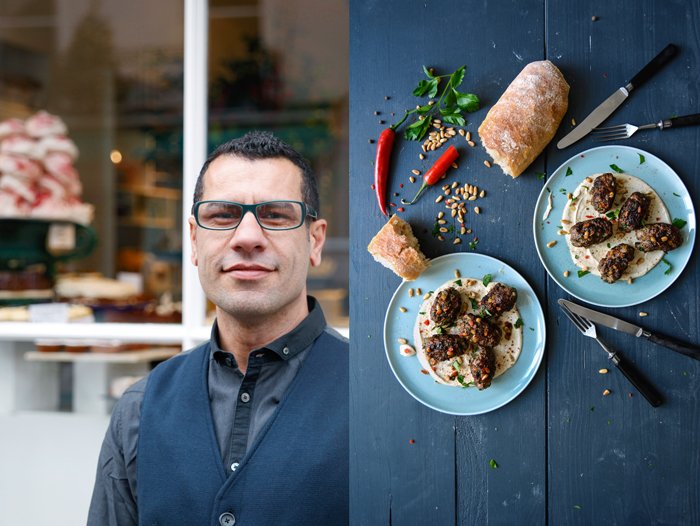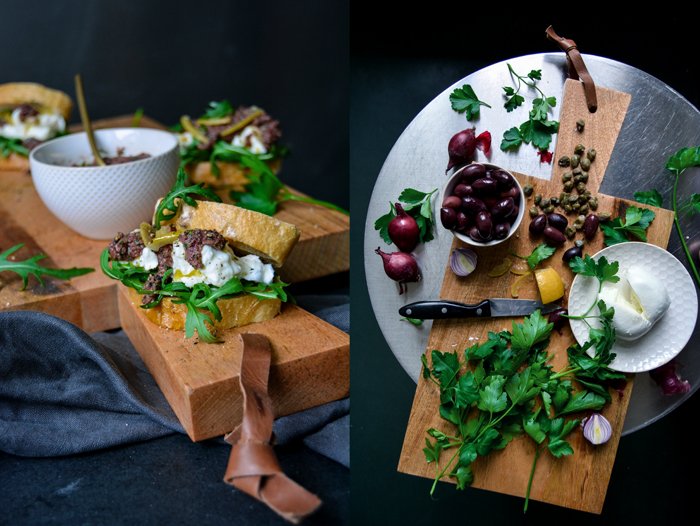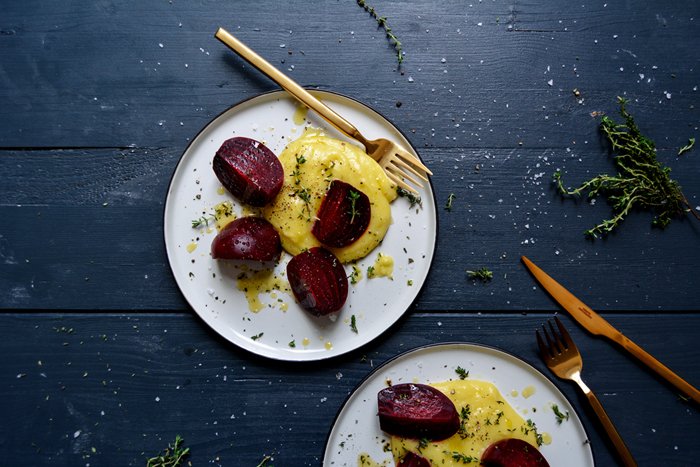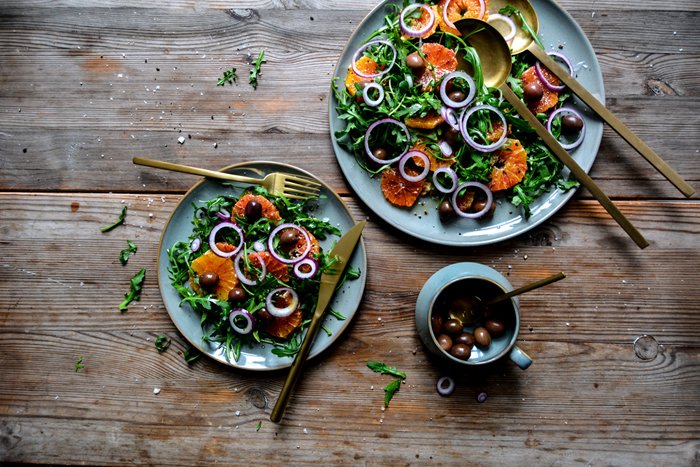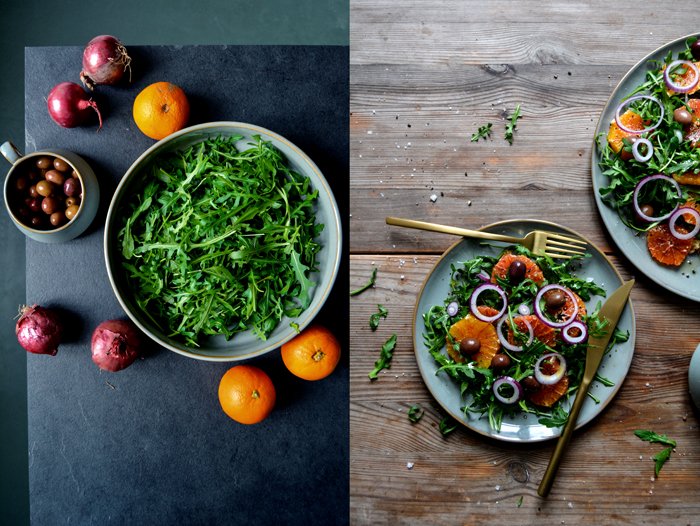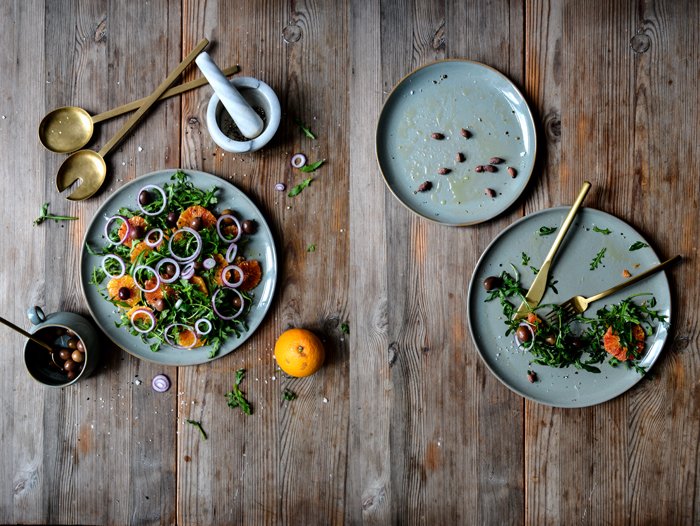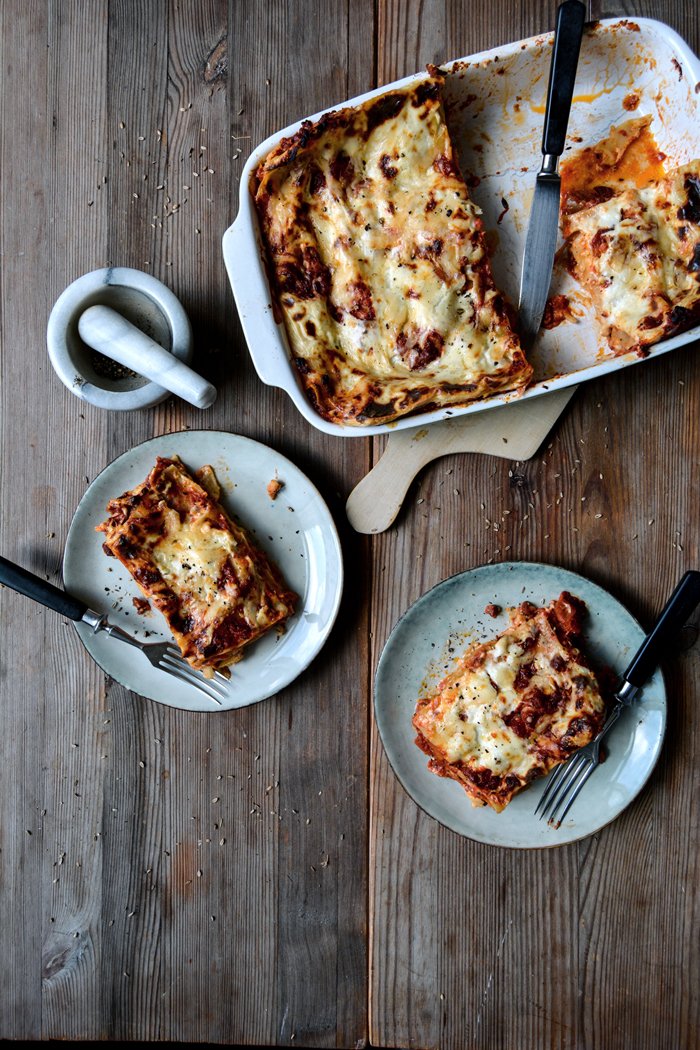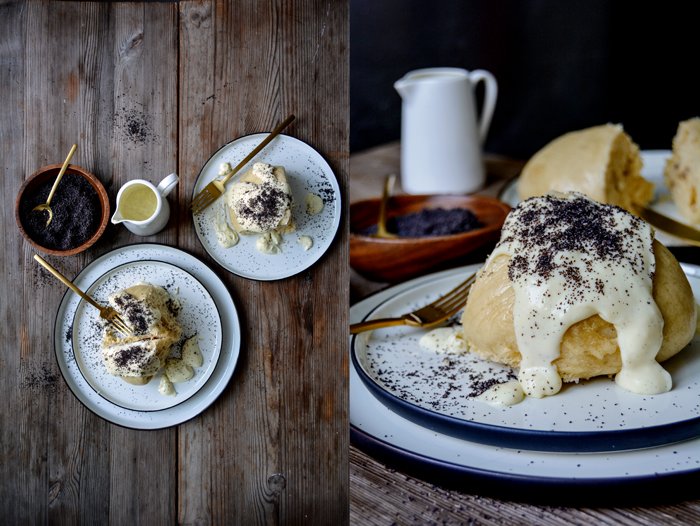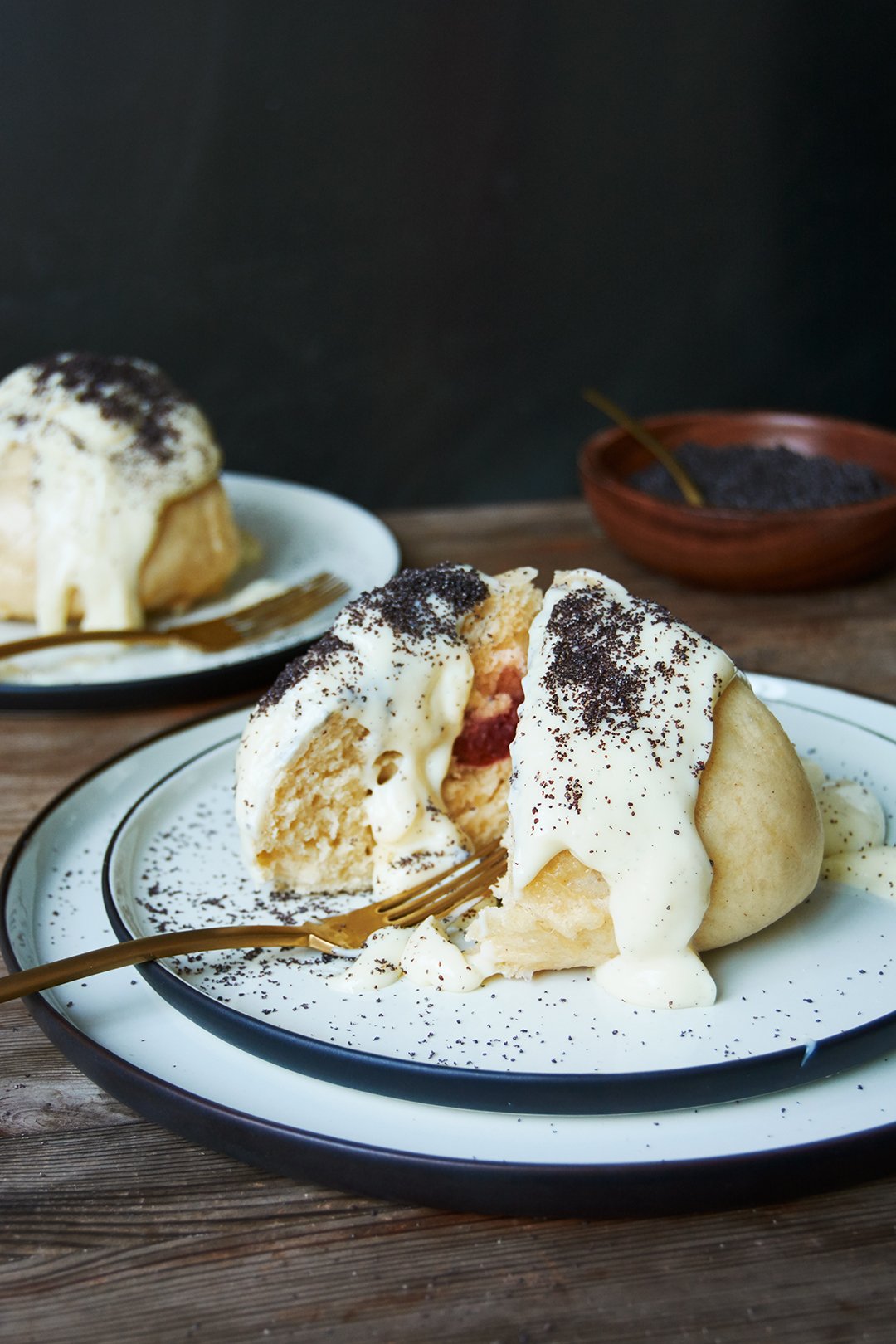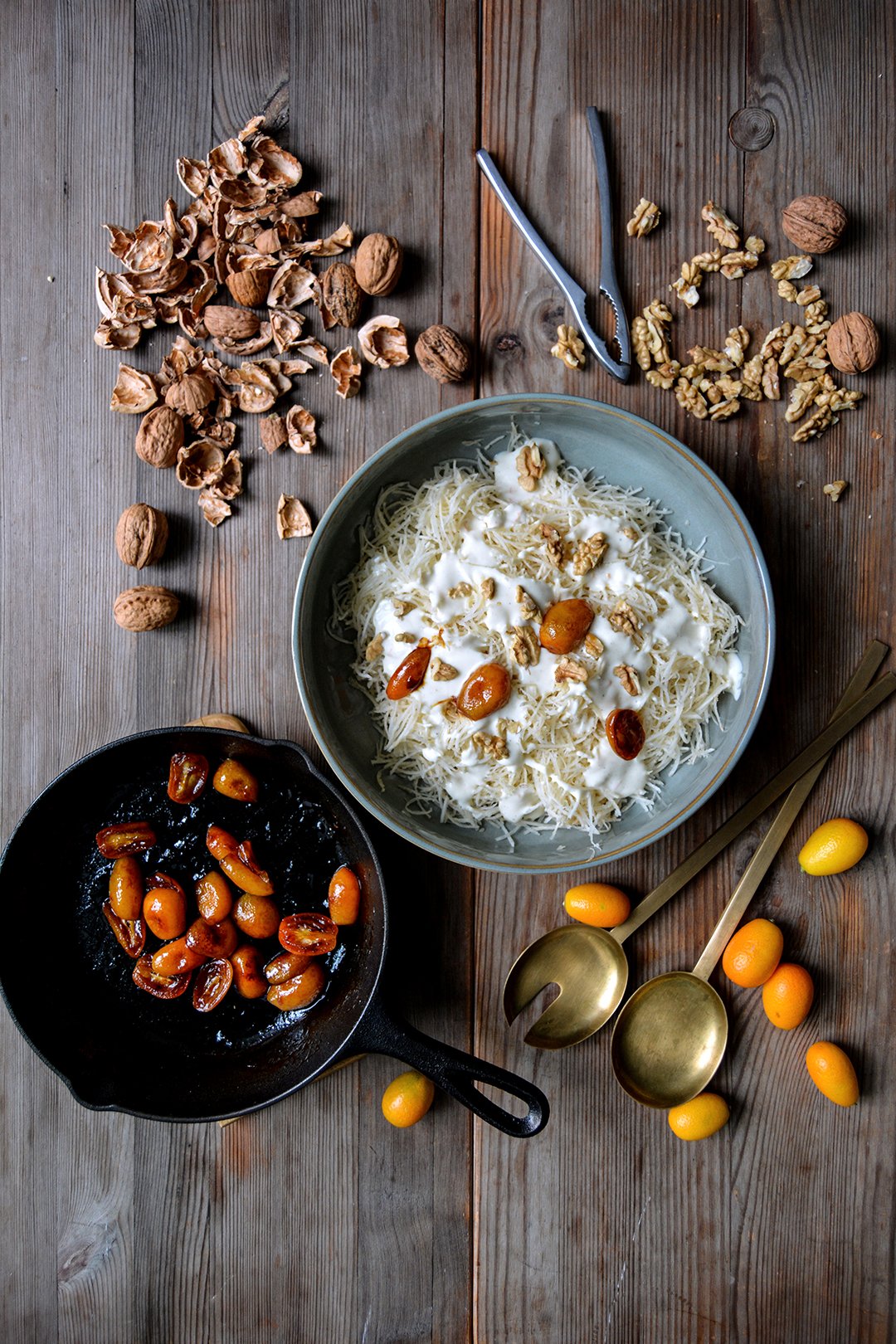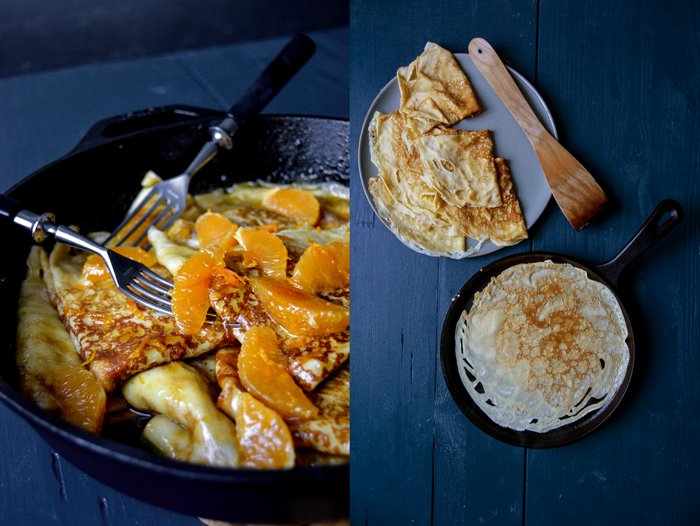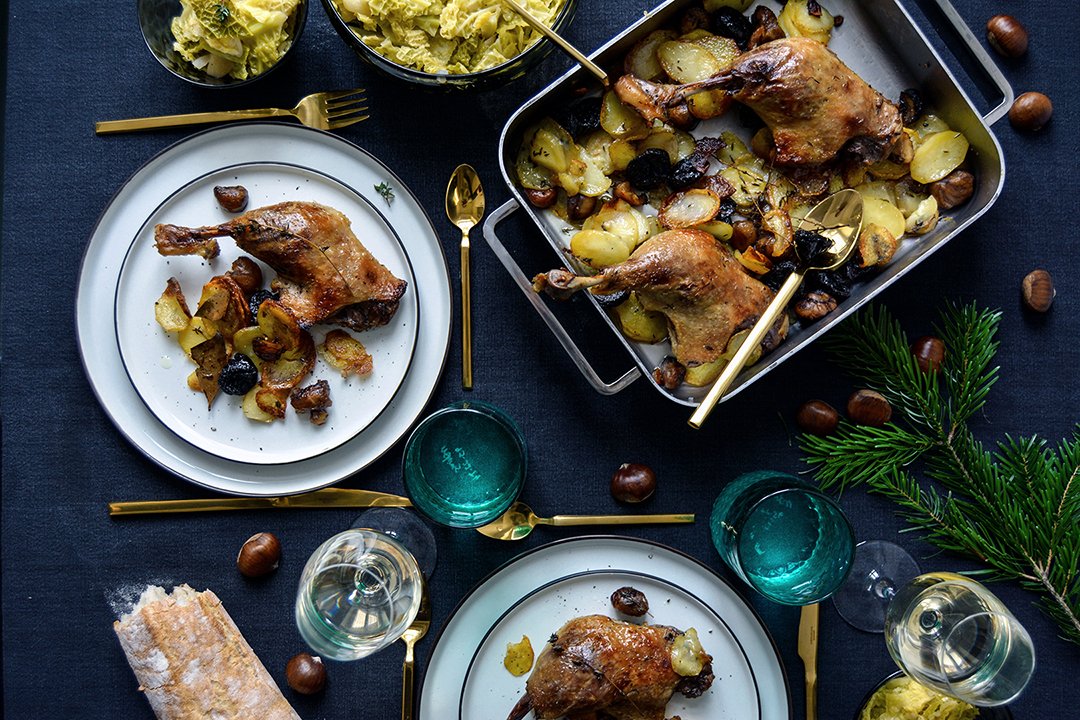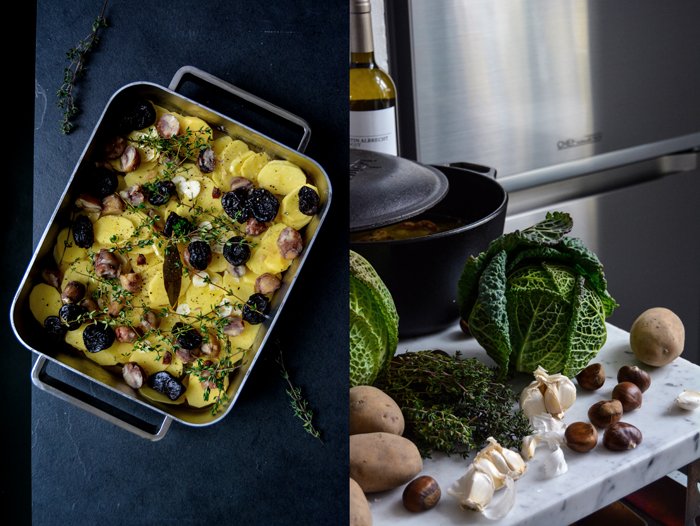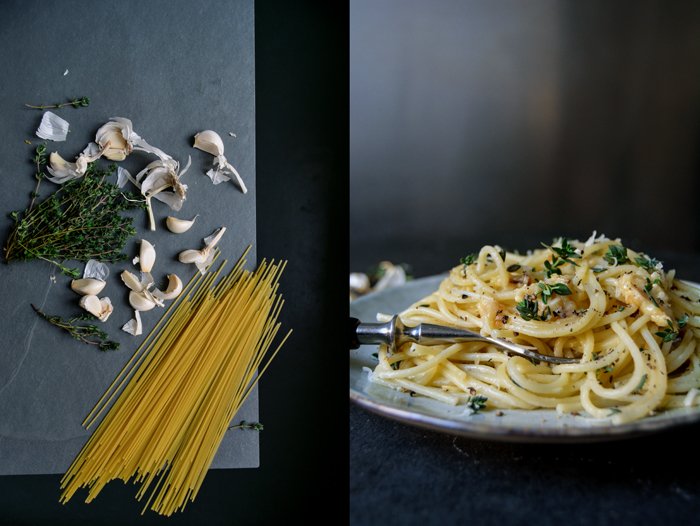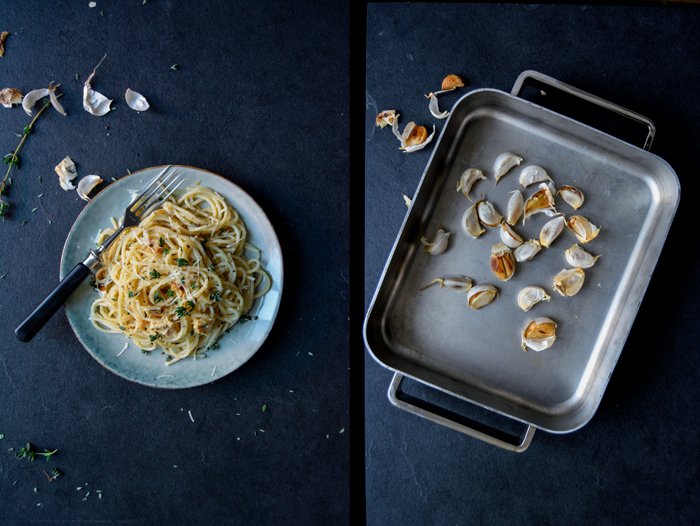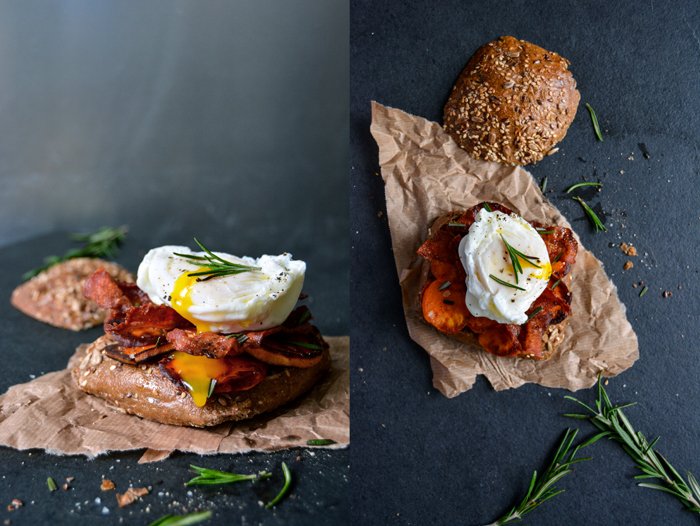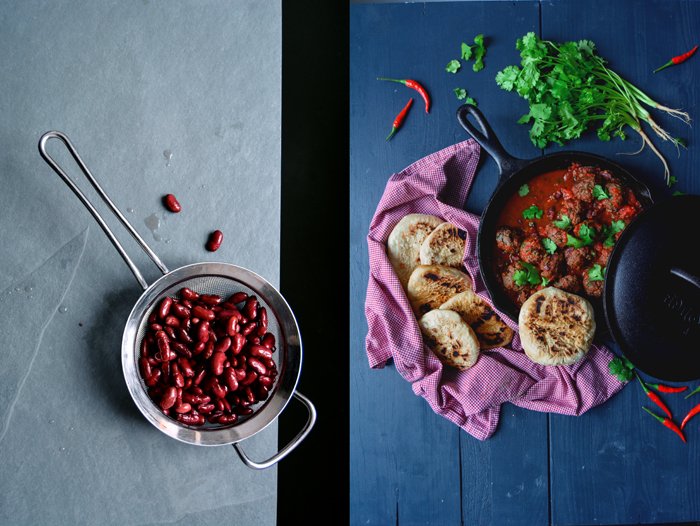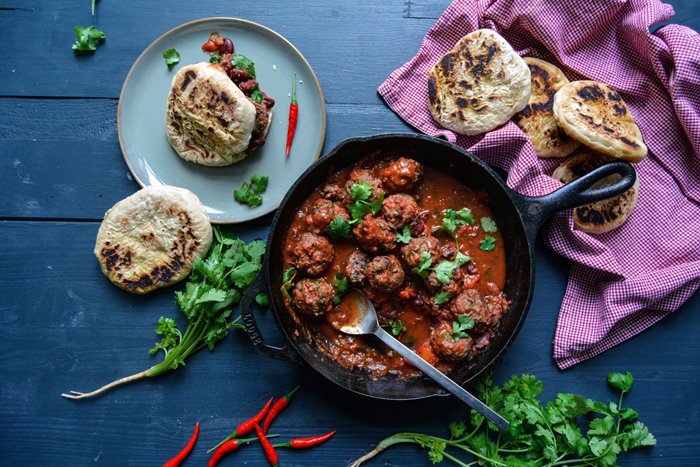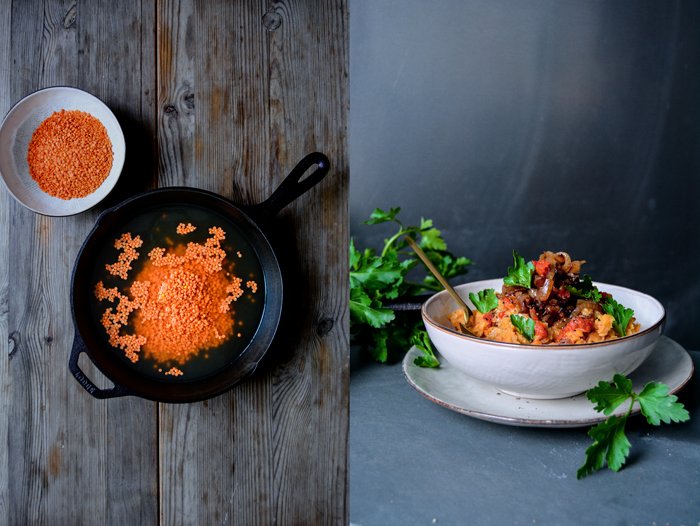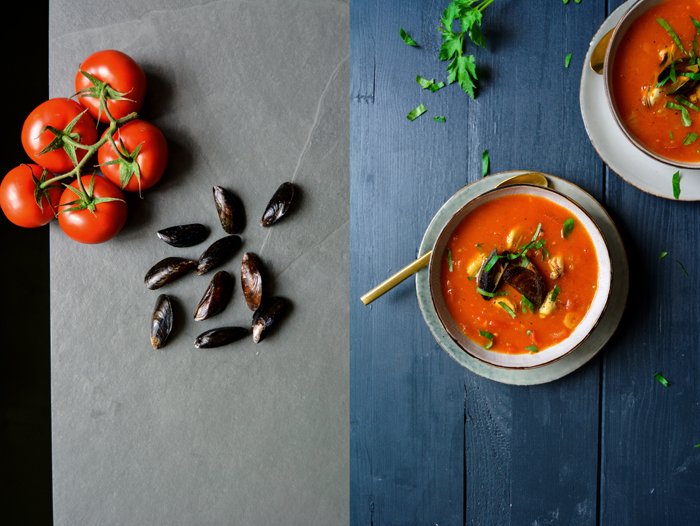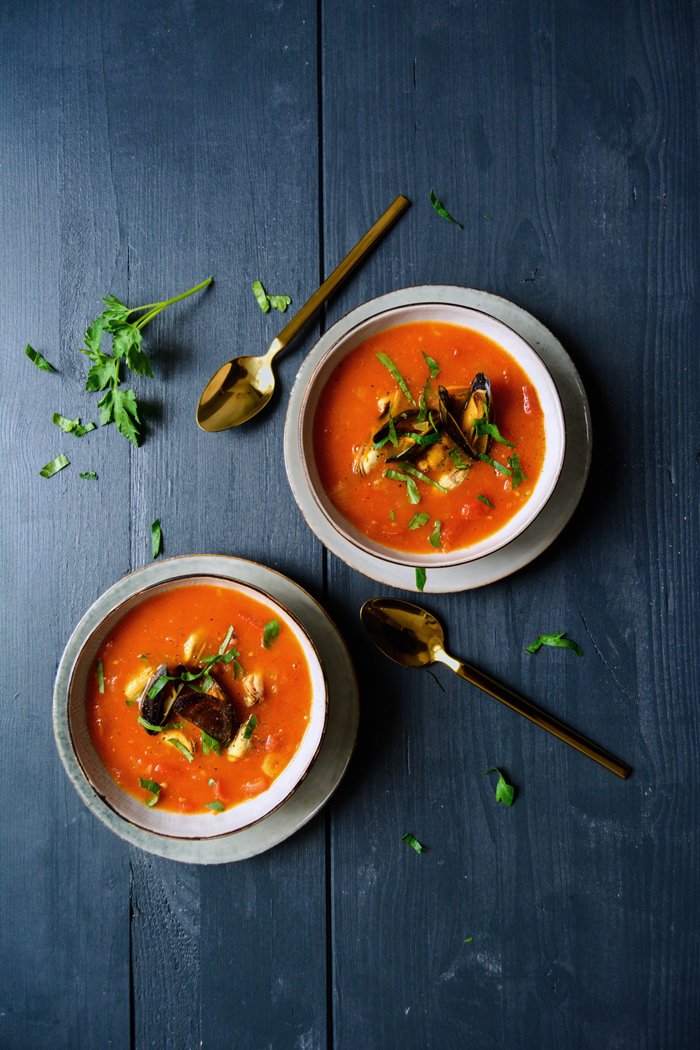meet in your kitchen | Sami Tamimi's Kofta b'siniyah with Tahini Sauce
If you love cooking and cookbooks, you've probably come across Sami Tamimi's name, either on the cover of Ottolenghi: The Cookbook or Jerusalem - both award-winning bestsellers. But who is the man who co-wrote these beautiful recipe collections and started some of the most talked about restaurants on the London food scene together with his friend from Israel? While the whole world seeks fame and attention, what drives a man to stay in the background and concentrate on what he loves the most: to cook and create recipes? The more I got to know about Sami, the more I understood his decision to be the chef in the kitchen and not the star in the spotlight.
Growing up in the Old City of East Jerusalem and feeling the restrictions of life in a traditional Muslim family, he left home at the age of seventeen and headed to Tel Aviv. The ambitious young man worked hard and became a chef at one of the country's best restaurants. But Sami was hungry, he wanted to learn and evolve even more: London was next and with it the beginning of a beautiful story of friendship, great food, and success. A story of two men, whose ideas, dreams, and creativity are inseparably woven into each other.
Sami and Yotam first met at Baker & Spice in London, where Sami had developed a food concept quite similar to the one we know from the Ottolenghi restaurants in Islington, Belgravia, Notting Hill, and Spitalfields. Lusciously filled platters of Middle Eastern and Mediterranean dishes, so pleasing to the eyes that one can't help but stop at the first glance. You might not be hungry, but after a quick look through the large windows you'll fall for the tempting displays - they seem to call your name.
Yotam must have felt the same when he passed the restaurant back in 1999. He hopped off his scooter and started talking to Sami. They got along well straight away, so he joined him in the kitchen, and became responsible for the pastry. What happened next is one of the many reasons I love life: a simple idea became reality through hard work and dedication. They decided to open their own place and put their individual skills together to make it happen. The rest is history. In its honesty, Sami's view of the story touches me: “It was Yotam’s vision and his dream. The work was his. The stake was his. I didn’t have money to invest. He risked everything he had. A few years later, I became a partner, but regardless of the cookbooks we do, regardless of our friendship, I’m still working for Yotam. He’s my boss”. But as much as his friend was the visionary, in the end it was also Sami's creative concept for food, which became what we know as Ottolenghi today. These two men, aware of their individual strengths, put it all together and turned it into something greater.
Having cooked and baked with Jerusalem, enjoying it every time I pull it off my shelf, it felt even more exciting to choose one of the recipes from the book together with Sami to share with you. We didn't manage to meet in London, but cooking his kofta here in Berlin, working on the interview with him, and learning so much about and from this inspiring man, made me feel once more that the kitchen is often the best place to get to know someone.
I made Sami's kofta and I loved it. It was nothing less than heavenly: the little oval meatballs are juicy, packed with nutty pine, parsley, spicy garlic and chilli. Sami lays them on a tahini-lemon sauce, a smooth and creamy contrast to the fragrant meat. It's one of those dishes that make you wish you had made twice as much.
Here's a great article by Jane Kramer about Yotam and Sami in The New Yorker, which I can recommend if you need a little inspiration for life.
Sami Tamimi's Kofta b'siniyah
Recipe from Jerusalem by Yotam Ottolenghi and Sami Tamimi.
For these kofta, buy your meat freshly minced by your butcher, if you can. The lamb should be shoulder and the beef a good non-stewing cut. If you get the meat from a supermarket or another grocer, cook it through, just to be on the safe side. Finish the dish with butter only if you are serving it straight away and consuming it all at once. Otherwise, leave it out as it sets quickly, which isn't very nice. Serve with pita (I used ciabatta).
Serves 6 / makes 18 kofta
For serving
light tahini paste 150g / 5 ounces
freshly squeezed lemon juice 3 tablespoons
water 120ml / 1/2 cup
medium garlic clove, crushed, 1
sunflower oil 2 tablespoons
unsalted butter or ghee 30g / 2 tablespoons (optional)
sweet paprika, to garnish
fine sea salt
For the kofta
minced lamb 400g / 14 ounces
minced veal or beef 400g /14 ounces
onion, finely chopped, 1 (about 150g / 5 ounces)
large garlic cloves, crushed, 2
toasted pine nuts, roughly chopped, 50g / 2 ounces, plus extra whole ones to garnish
flat-leaf parsley leaves, finely chopped, 30g / 1 ounce, plus extra to garnish
large medium-hot red chilli, deseeded and finely chopped, 1
ground cinnamon 1 1/2 teaspoons
ground allspice 1 1/2 teaspoons
grated nutmeg 3/4 teaspoon
ground black pepper 1 1/2 teaspoons
fine sea salt 1 1/2 teaspoons
If the tahini-lemon sauce starts to curdle, slowly add more water and continue whisking or pulsing it in a blender until smooth.
Put all the kofta ingredients in a bowl and use your hands to mix everything together. Now shape into long, torpedo-like fingers, roughly 8cm / 3" long. Press the mix to compress it and ensure the kofta is tight and keeps its shape. Arrange on a plate and chill until you are ready to cook them, for up to 1 day.
Preheat the oven to 220°C / 425°F. In a medium bowl, whisk together the tahini paste, lemon juice, water, garlic, and 1/4 teaspoon of salt. You can also use a blender or food processor. The sauce should be a bit runnier than honey; add 1-2 tablespoons of water if needed.
Heat the sunflower oil in a large pan and sear the kofta, in batches, over high heat. Sear on all sides until golden brown, for about 6 minutes. At this point they should be medium-rare. Transfer the kofta to a baking dish and cook in the oven for 2-4 minutes (medium or well done). I cooked mine for 8 minutes in the pan and skipped the oven. I spread the tahini sauce on plates and laid the kofta on top, then I continued with the garnish.
Spoon the tahini sauce around the kofta, so it covers the base of the baking dish. Place in the oven for 1-2 minutes to warm up the sauce.
Meanwhile, if you're using the butter, melt it in a small saucepan and allow it to brown a little, taking care that it doesn't burn. Spoon the butter over the kofta as soon as they come out of the oven. I skipped the butter and used the frying juices from the pan instead. Scatter with pine nuts and parsley and finally sprinkle some paprika on top. Serve immediately.
What made you leave Israel and move to London?
I’d been cooking for many years in Israel. After a good time at Lilith, one of the top restaurants in the country, I was beginning to reach my full potential. I knew if I wanted to keep learning and growing I’d need to look further afield. I’d visited London a few times and fallen in love with it so it was the obvious place to go. The political situation was also getting worse by then and the levels of stress were getting higher. I wanted a change from that.
You say you're more into savoury than sweet baking, what do you like about the process of creating savoury recipes? Why do you prefer it to sweets?
I find I have more creative freedom with savoury cooking. Baking and sweet cooking in general is often quite a science: everything needs to be measured for the result to work out. What goes into savoury cooking can change much more, depending on the day and the mood and what you have to hand. I love that freedom. Also, I can’t stand all the flour that gets everywhere! I like my kitchen clean and tidy.
You lived in Tel Aviv for 12 years, a city known for its vibrant food scene, what makes it so special? What do you miss the most about the food in Israel?
I haven’t lived in Tel Aviv for 17 years so the food scene has changed a lot. I guess what makes it vibrant is people’s passion for the food and people often basing their social life around food. There are a lot of young people who travel the world from Tel Aviv and then return with all sorts of knowledge about different cuisines: that makes it a really creative place.
Do you find creative inspiration in the British cuisine? Do you have a favourite British dish?
We have some wonderful products and raw ingredients here, which are a constant inspiration. There are also a few local chefs who I get a lot of inspiration from: Simon Hopkinson and Nigel Slater, to name just two. I’ve lived in the UK for many years now so I have come to love some of the classic British dishes: Apple or pear and rhubarb crumble, beef wellington and so on.
Is it harder or easier to work with a close friend (Yotam Ottolenghi)? How did your friendship change through the experience of writing books and running restaurants together?
Yotam and I started to work together long before Ottolenghi was born. Combining friendship and business is not always a good thing but we’ve been doing it for many years now and have perfected the way of working together without it effecting our friendship. We see each other a lot and are constantly checking in with each other but our day-to-day jobs are very different. Yotam is based in the test kitchen and I am based in the restaurants so our roles are pretty separate from each other.
You've co-written Ottolenghi: The Cookbook andJerusalem, what is your favourite part of the process of writing a cookbook?
For Jerusalem, cooking at home, alone, in my kitchen and then sharing childhood memories and stories sparked from the food was my favourite part. The Ottolenghi: The Cookbook was harder for us: It’s the first child thing, you are making it up as you go along so it took longer to work out what we were doing! Jerusalem was easier technically but harder emotionally.
What advice can you give young chefs?
Being a chef is hard work: the stress levels are high, the hours are long and you don’t get to sit down or sleep much! Before you spend a lot of time and money going to cookery school, people should always do a stint in a commercial kitchen to see whether the job is for them. There is so much more to the job than just making food look pretty! You need to start with passion and love and then add some hard graft and dedication. And then you can start making the food look pretty!
You write poetry in Arabic and you paint, does this bring you relaxation or inspiration?Writing poetry, painting, photography, cooking, it’s all part of the same process, for me: a way of expressing myself, saying something about the world we are living in.
Do you like to cook at home?
Cooking at home is what keeps me in love with food. I cook at home every evening, even after a long day working with food.
Who is your biggest inspiration in the kitchen?
My mother. She was an amazing cook.
Was food, cooking, and eating a big topic in your family while growing up?
Yes, it was. The kitchen was the heart of the house and my family. When we were having breakfast we’d be discussing what to have for lunch. Chats at lunch were about what we were having for supper. Food was always on the go, being prepared or cooked.
What was the first dish you cooked on your own, what is your first cooking memory?
I cooked all the time, from a very young age: I’d be making it up if I said I could remember my first dish!
What are your favourite places to buy and enjoy food in London?
I tend to go to small Middle Eastern shops in west London for my food grocery because the fruit and vegetables come from sunny places and therefore they taste much better, plus I can find all the ingredients for Palestinian cooking.
If you could choose one person to cook a meal for you, who and what would it be?
My mother. Anything she will cook will be delicious.
You're going to have ten friends over for a spontaneous dinner, what will be on the table?
Many dishes to share and lots of food: if it was a Palestinian spread they’d be Maqluba, okra in tomato sauce, Bamieh Bil Zeit and Mujaddara, lentils and rice with lots of fried onions, to mention just three dishes.
What was your childhood's culinary favourite and what is it now?
I love Palestinian food and still do. I also love Japanese, Mexican, Thai and Nordic food.
Do you prefer to cook on your own or together with others?
When I'm at work then of course with others and it's much more fun. But when I’m cooking at home, I like to be alone, with music.
Which meals do you prefer, improvised or planned?
Some days I'll wake up with a dish in mind and then I'll make it but most times I just go to the shops and decide then, according to what I find and what's in season.
Which meal would you never cook again?
I have recently made Turkish Su Böreği or as some call it, water borek. I'll never attempt to do it again. It was so hard and complicated. The end result is delicious but honestly, I can live happily with myself knowing that I've cooked it once in my lifetime and I'll only be ever eating it in Turkey.
Thank you Sami!
Mozzarella di Bufala and Olive Tapenade Sandwich with Preserved Lemon
The best sandwiches are often the ones that are thrown together in just a few minutes. You grab whatever your fridge offers without overloading the whole composition and straining your taste buds. Just a few contrasting flavours and textures, the bread has to be fresh - soft and juicy to soak up the filling - and you're done.
Cheese is made for sandwiches and mozzarella is always a good choice, the creamier mozzarella di bufala or burrata are even better. A dark tapenade made of black olives, capers, and anchovy adds depth, refined with a handful of fresh parsley. This lies on a bed of arugula, the spicy leaves go so well with preserved lemons, which I use for the salty-sour topping. You can find them in big supermarkets but I recommend preserving your own. Tucked in a jar with lots of coarse sea salt for a month, the citrus fruit slowly becomes soft and ready to add some tangy bite to meat and vegetable dishes - or sandwiches.
I developed this sandwich recipe for the West Elm blog, where you can also find this recipe and the wooden chopping board you see in the pictures - it's just the right size for a loaf of bread and some cheese for late evening cravings on the sofa. The linen napkin and stoneware bowl and plate are also from their shop. This post was sponsored by West Elm to make my kitchen a little prettier!
Mozzarella di Bufala and Olive Tapenade Sandwich with Preserved Lemon
You can use leftover tapenade for spaghetti.
Makes 4 small sandwiches
For the olive tapenade
pitted black olives, preferably Kalamata, 100g / 3 1/2 ounces
flat-leaf parsley leaves 10g / 1 small handful
small red onion, chopped, 1/2
capers, preferably preserved in salt, rinsed and dried, 1 tablespoon
anchovy filet, rinsed, 1 (optional)olive oil 6 tablespoons
freshly squeezed lemon juice 1 tablespoon
Dijon mustard 1 teaspoon
ground pepper
For the sandwiches
ciabatta, 8 small slices
fresh rucola, 1 handful
mozzarella di bufala, torn into small pieces, 125g / 4 1/2 ounces
preserved lemon, thinly sliced, 1/4
black peppercorns, crushed in a mortar
For the tapenade, purée the olives, parsley, onion, capers, anchovy (optional), olive oil, lemon juice, mustard, and pepper in a blender or food processor until smooth. Season with additional mustard, lemon juice, and pepper to taste.
Divide the rucola and mozzarella between 4 slices of bread and sprinkle with the tapenade, preserved lemon, and crushed pepper.
Beetroot and Skordalia - a velvety Greek Garlic Potato Dip
If you feel like garlicky mayonnaise but you're pushed away by its oily heaviness, cook some garlic and potatoes, then throw them in a blender, and you'll end up with skordalia. This popular Greek dip has a similar smooth texture if you pulse it - it becomes thick, sticky, and starchy. The added olive oil adds a Mediterranean touch and taste to it and makes it feel like velvet. If you use a potato masher, which is more common, it will be more chunky, like mashed potatoes, so it really depends on what kind of dip you're after. I was in a mayonnaise kind of mood so the blender was my tool of choice.
Skordalia is a new discovery for me and I don't know how I never heard of it or tasted it before. I love Greek food, I've been to Greece, and I ate my way through countless Greek restaurants, but for whatever reason, I never had it on my plate until now. So I'm keeping up and made an extra large batch of it. To balance the sweetness of the potatoes and garlic, I brought in some earthy flavours: Beetroots cooked in their skins along with a bay leaf. Peeled and still warm, I cut the purple roots into wedges, and served them with generous (!) amounts of my creamy dip. Delicious!
Beetroot and Skordalia - a Greek Garlic Potato Dip
Serves 2
For the beets
medium sized beetroots, unpeeled, 2
bay leaves 2
fine sea salt
For the skordalia
peeled potatoes, diced, about 240g / 8 1/2 ounces
large garlic cloves, unpeeled, 6
olive oil 4 tablespoons
fine sea salt
For the topping
fresh thyme leaves, about 2 tablespoons
flaky sea salt
black peppercorns, crushed in a mortar
Cook the beetroot along with the bay leaves in plenty of salted water on medium heat for about 40-50 minutes or until tender. Check the roots with a metal skewer, they should almost feel soft. Rinse under cold water and let them cool for a few minutes before you peel off their skins. Cut each beetroot into 4 wedges.
In a medium pot, bring the potatoes in plenty of salted water to the boil and cook for 10 minutes. Add the garlic and cook for another 5 minutes or until the potatoes are soft. Drain and quickly rinse with cold water. Peel the garlic and add, along with the potatoes, to a blender or food processor. Add the olive oil and a little salt and pulse until smooth. Season with salt to taste. Divide the beetroot wedges and skordalia between plates and sprinkle with thyme, flaky sea salt and crushed pepper. Enjoy cold or warm.
Sicilian Blood Orange, Olive, and Red Onion Salad
The past mornings have been rather cloudy and grey and to make it even worse, they pulled my beloved wild vine off the wall opposite my kitchen window, which I used to call my vertical garden - the poor thing damaged the bricks. My little garden is gone. So the mood hasn't been very uplifting. And as I sat at the table in my kitchen, chewing over a new exciting meet in your kitchen features that I've been working on over the past few days and that I'm eager to share with you, I had to decide to postpone it. The feature was supposed to be up on the blog this week, but unfortunately, my guest from afar - Australia - is opening his second restaurant and so busy that we couldn't finish the interview yet. I felt a bit sad, or rather frustrated, because I adore his work and I'm so curious to read his answers and to get to know him a bit better. In these moments, I can be like a little child, impatient and not willing to accept reality - in this case: having to wait.
Food is the best cure for disappointment, at least in my case, so I looked around my kitchen to see what I could use to throw together for a quick and uplifting lunch. As I spotted a bunch of ripe blood oranges, I remembered a Sicilian salad made with the sweet citrus fruits, olives, and red onions. I added some rucola, olive oil, flaky sea salt, and crushed peppercorns and enjoyed the colourful plate in front of me just as much as the fresh taste of this delicious composition. Needless to say, my mood was much better after the first bite. The sweetness of the oranges merges perfectly with the spicy rucola and onions and the dark and oily depth of the olives. And it's put together in just a few minutes - it's a keeper!
Blood Orange, Olive, and Red Onion Salad with Rucola
Serves 2-4
fresh rucola leaves, 2 handfuls
small blood oranges, peeled (outer skin and white pith), cut into rounds, 4
small red onion, cut into slim rings, 1-2
black olives with pit 12-16
olive oil
flaky sea salt
black peppercorns, crushed in a mortar
Divide the rucola between plates. Lay the blood oranges, onion, and olives on top. Drizzle with some olive oil and season with flaky sea salt and crushed pepper to taste. Serve immediately, preferably with soft ciabatta.
Fennel Tomato Lasagna with Crunchy Bacon
A couple days ago, I went to a meeting that finished much earlier than expected. I stepped out into the street on that cold and grey morning and decided to squeeze in a quick coffee. Just a creamy cappuccino, a flaky chocolate croissant, and a peaceful moment to myself. I went to my favorite Italian deli for a bit of dolce vita - sipping a fantastic coffee while listening to the patron chatting with his customers in Italian, accompanied by a medley of Italian operas. A toddler giggled, two dogs observed the busy scene. The shelves around me presented a tempting selection of chiantis, pasta, polenta, capers, and bottarga. The counter right in front of me filled with various prosciuttos, salami, ciabatta sandwiches, and homemade pasta treats. And right next to it, bowls of every antipasti one can possibly think of. Just the thought of it makes me hungry again.
This is the kind of scene that makes you want to go straight to your kitchen, open a bottle of wine, and start cooking. Italian of course. The weather doesn't leave the slightest doubt that spring isn't near yet, so a hearty lasagna is the best thing to have on your plate. Mine is filled with lots of juicy tomatoes, roasted fennel seeds, and fennel bulb thinly sliced and sautéed, plus crunchy bacon bites, dried chili peppers, a bit of Parmesan, and a creamy béchamel sauce. At first, I wanted to combine the fennel with a meaty bolognese but then I remembered a pasta dish that I shared on the blog almost two years ago and that changed my mind. You could leave out the bacon, but I recommend leaving it in: the fennel seeds roast in the meat's salty juices and merge with the tinned tomatoes - and become a heavenly sauce. Layered with pasta sheets and the crisp fennel bulb, it's just what I want on a cold day in February.
Fennel Tomato Lasagna with Crunchy Bacon
Serves 4 to 6
For the béchamel sauce
milk 700 ml / 3 cups
a pinch of nutmeg, preferably freshly grated
fine sea salt
ground pepper
unsalted butter 30g / 2 tablespoons
plain flour 30g / 4 tablespoons
large bay leaf 1
For the lasagna
butter, for the baking dish
olive oil
cored fennel bulb, thinly sliced lengthwise, 340g / 12 ounces
fine sea salt
black peppercorns, crushed in a mortar
thick-cut bacon, cut into very small cubes, 200g / 7 ounces
fennel seeds 2 tablespoons
garlic, crushed, 3 cloves
small dried chili peppers, 2
peeled whole tinned tomatoes, chopped, 1.2kg / 2 2/3 pounds
no-boil lasagna noodles, about 250g / 9 ounces
freshly grated Parmesan 100g / 3 1/2 ounces
For the béchamel sauce, combine the milk, nutmeg, and pinches of salt and pepper in a medium saucepan and bring to a boil. Immediately take the pan off the heat and set aside.
To make the roux for the béchamel, melt the butter in a clean medium saucepan over medium-high heat and as soon as it’s sizzling hot, whisk in the flour. Slowly pour the hot milk mixture into the roux and whisk until smooth. Add the bay leaf and simmer on low, whisking occasionally, for 2 to 3 minutes or until the texture starts to thicken. Remove and discard the bay leaf. Season to taste with nutmeg, salt, and pepper then cover, and set aside.
Preheat the oven to 180°C / 350°F (conventional setting) and butter a 26 x 20 cm / 10 x 8" baking dish (or a dish of roughly this size).
In a large, heavy pan, heat a generous splash of olive oil over medium-high heat and sauté the fennel slices in batches for about 1 minute per side or until golden and al dente. Spread out the fennel slices next to each other in the pan so that they cook evenly. Season with salt and pepper and transfer to a plate.
Put the pan back on the heat and cook the bacon over medium-high heat for about 7-10 minutes or until golden brown and crunchy. Add a little oil if necessary and stir once in a while. Scrape the bacon to the sides of the pan, add a little olive oil (if the pan is too dry) and the fennel seeds, garlic, and chili. Turn the heat down to medium and cook for 2 minutes, mind that the seeds don't turn too dark. Add the tomatoes, season with salt and pepper, and, stirring occasionally, cook for about 10 minutes over medium-high heat or until thickened. Season with salt and pepper to taste. Take the pan off the heat and set aside 3 tablespoons of the sauce (for the final layer of the lasagna).
Arrange a layer of pasta on the bottom of the buttered baking dish and spread with 1/3 of the tomato-bacon sauce and sprinkle with 1/4 of the béchamel. Top with 1/3 of the sautéed fennel and 1/4 of the Parmesan. Repeat to make 3 more layers, top the last layer with pasta. Sprinkle with the reserved 3 tablespoons of the tomato-bacon sauce and the remaining béchamel and Parmesan. Bake for 35-45 minutes (depending on the lasagna package instructions) or until the pasta is al dente. To brown the cheese a little, you can switch on the broiler for the last 1 to 2 minutes. Let the lasagna sit for 5 to 10 minutes before serving and sprinkle with some crushed peppercorns. Enjoy!
Potato and Apple Stuffed Cabbage Rolls with Walnut Butter and Gruyère
Here we are again: I've reached that critical time of the year - as always in February - when it's still all about cabbage and roots at the market, but I start dreaming of juicy tomatoes and cucumbers, sweet berries and peaches, and seafood dinners at the sea - my mind, impatient and hungry, is already settled in summer.
Luckily, February is quite a short month, then we have March, which at least offers ramps towards its end. In April I can feel the sun getting warmer, the sky becomes brighter, and the produce on my counter tops slowly starts to look more colorful. But for now, I must wait and enjoy what I've got - a beautiful crisp head of cabbage.
I blanched the large outer cabbage leaves and stuffed them with boiled potatoes, sour apple, fresh thyme, and a few spoonfuls of mascarpone, instead of sour cream, to bind the mixture. My personal highlight was the topping of crunchy walnut butter and freshly grated Gruyère. Any aromatic hard cheese would work here, but there's something about this combination of the roasted nuts and this slightly sweet Swiss cheese that fits perfectly to these little wintery cabbage packages.
Potato and Apple Stuffed Cabbage Rolls with Walnut Butter and Gruyère
For the cabbage rolls
large white or green cabbage leaves 8
peeled potatoes, boiled and chopped, about 250g / 9 ounces
small apple, peeled, cored and chopped, 1
fresh thyme leaves 1 tablespoon
mascarpone (or sour cream or ricotta) 3 tablespoons
organic egg 1
nutmeg, preferably freshly grated
fine sea salt
ground pepper
white wine
For the walnut butter
butter 60g / 1/4 cup
walnuts, roughly chopped, 25g / 1 ounce
For the topping
Gruyère, or any aromatic hard cheese, finely grated, about 2 tablespoons
a few fresh thyme leaves
black peppercorns, crushed in a mortar
For the cabbage leaves, take a large cabbage head and trim the bottom. Carefully peel off 8 large outer leaves. If they tear a little, it's fine. You'll only need 4-5 blanched leaves, blanch the remaining leaves to cover torn patches in the leaves that you use for the rolls.
Preheat the oven to 200°C / 400°F.
In a large pot, bring salted water to the boil and blanch the cabbage leaves for about 4-6 minutes or until tender. Rinse quickly under cold water, drain and cut out the hard stalk (in a slim triangle-shape).
For the filling, in a large bowl, combine the boiled potatoes, apple, and thyme. Whisk together the mascarpone and egg and season with salt, pepper and nutmeg. Add to the potato-apple mixture, stir to combine, and season with salt and pepper to taste.
Lay 4-5 cabbage leaves flat on the kitchen counter and cover torn parts with soft pieces of the remaining leaves. Put a generous tablespoon of the filling in the middle of each cabbage leaf, fold up the sides and roll it up, starting from the side of the stalk. Don't worry if they don't look perfect, mine didn't either. They can all have their individual shape.
Transfer the cabbage rolls to a baking dish and cover the bottom with a splash of white wine and some water. Bake in the oven for about 30-35 minutes or until golden and firm.
While the cabbage rolls are baking in the oven, prepare the walnut butter: In a small saucepan, melt the butter on high heat. When it's sizzling hot, add the walnuts and turn the heat down to medium. Roast for 10-20 seconds or until golden but not dark. Take the saucepan off the heat.
Divide the cabbage rolls between plates and drizzle with a little butter. Sprinkle with the roasted walnuts, fresh thyme, Gruyère, and crushed pepper.
Beet Ricotta and Roast Shallot Sandwich with Spinach and Fried Thyme
Few things frustrate me as much as trying to make vegetable chips and failing completely. The kitchen is in mess, everything is coated in a layer of oil (including myself) and the result is so hopelessly bad that it has to go right into the bin. My parsnip chips from a couple months ago turned out so perfectly that I felt brave enough to think it would be that easy with any kind of roots or greens. But I was wrong. I had thin, crisp beetroot and spinach bites on my mind but a burnt disaster on my plate. It was so frustrating as I already had the perfect sandwich for this composition ready in my head: the chips were supposed to lay gracefully on a bad of sweet, juicy shallots roasted in the oven in their skins. I could already see the bright purple and green screaming in front of the pale onions. But reality was different. There was no bright anything but a black, bitter disaster.
I know I should have done it before, but afterwards I read and learned that beet chips can be cooked in the oven, which should be much easier. At that point my mood had reached such a low point that I decided to go for a different creation. I looked at the two beetroots that were lucky enough to escape the scorching hot oil in the pan and stuffed one of them in a blender along with some fresh ricotta, olive oil, thyme, and lemon juice. You could boil the root first but I actually enjoyed the crunchy raw bites in the dip. Fried thyme was next and a success - the tiny leaves thrown into sizzling olive oil and taken off the heat immediately, were just right - neither dark nor bitter. And all this piled up on a thick leaf of raw spinach. You could make a juicy ciabatta sandwich with it but I was too lazy to go to the bakery so I grabbed my dark spelt potato bread. It added heartiness to the earthy flavours. This is a proper winter sandwich, stuffed with taste and vitamins.
Beet Ricotta and Roast Shallot Sandwich with Spinach and Fried Thyme
Makes 2 large sandwiches
For the roast shallots
medium shallots, in their skins, 8
olive oil 1 tablespoon
For the beet-ricotta dip
peeled beetroot, raw or boiled, roughly chopped, 120g / 4 ounces
fresh ricotta 100g / 3 1/2 ounces
olive oil 3 tablespoons
freshly squeezed lemon juice 1 teaspoon
fresh thyme leaves 1 heaping teaspoon
fine sea salt
ground pepper
For the fried thyme
olive oil 3 tablespoons
fresh thyme 8 small, young sprigs
For the sandwiches
dark bread 4 slices
large mature spinach leaves 4 (or a small handful of baby spinach)
black peppercorns crushed with a mortar
Preheat the oven to 425°F (220°C).
For the roast shallots, in a baking dish, toss the shallots with 1 tablespoon olive oil. Roast for 15 minutes, then turn them over and roast for 15 minutes on the other side. If they feel soft when you push them down gently, they’re done; set aside.
For the beet-ricotta dip, combine the ingredients in a blender or food processor and pulse until smooth. Season to taste with salt, pepper, and thyme. If the dip is too dry, add more olive oil.
For the fried thyme, heat the olive oil in a small saucepan over high heat, add the thyme sprigs. Take off the heat immediately and set aside.
Brush 2 slices of the bread with the thyme oil from the saucepan and cover with spinach leaves. Sprinkle with generous dollops of the beet-ricotta dip. Snip the ends off the roast shallots and squeeze them out of their skins onto the dip. Lay some fried thyme on top and sprinkle with crushed peppercorns. Close the sandwich and enjoy.
Beluga Lentils with Ginger Orange Rutabaga and Rosemary
I once read that the 3rd Monday of January is supposed to be the most depressing day of the year - Blue Monday. I don't know if it's true, luckily it has already passed, and I didn't notice my mood drooping drastically that day. However, I've felt a rising impatience for more light and warmer weather to come back into my life. So much so that I had to book flights to Malta last night. This always makes me feel so much better, no matter how far in the future the departure date lies, just the thought of it puts me in a good mood.
Another way to lift my spirits is food. Cosy food, colourful food, or simply delicious food. This dish combines all of it: nutty Beluga lentils, topped with thin slices of rutabaga, quickly cooked in the pan with lots of ginger, orange zest and juice, and fresh rosemary. The rustic root is as bright as the sunrise over Malta's east coast and its earthy flavour can easily deal with some strong aromas. I was surprised how well it merged with the dark legumes.
Beluga Lentils with Ginger Orange Rutabaga and Rosemary
Serves 3-4
For the lentils
Beluga lentils, or any lentils (no soaking required), 280 g / 10 ounces
small sprig fresh rosemary 1
bay leaf 1
olive oil
balsamic vinegar 1 tablespoon
fine sea salt
ground pepper
For the rutabaga
peeled rutabaga, cut into wedges and very thinly sliced (use a mandoline or cheese slicer), 300g / 10 1/2 ounces
freshly grated ginger 1 tablespoon
freshly grated zest of 1 orange
freshly squeezed orange juice 100ml / 1/3 cup plus 2 tablespoons
fine sea saltground pepper
finely chopped fresh rosemary needles 1-2 tablespoons
black peppercorns, crushed in a mortar
Place the lentils in a saucepan with plenty of (unsalted) water, add the rosemary and bay leaf, and bring to the boil. Simmer for about 20 minutes or until al dente (or follow the package instructions). Remove excess liquid with a ladle if necessary and stir in a generous splash of olive oil and the vinegar. Season to taste with salt, pepper and vinegar.
While the lentils are cooking, prepare the rutabaga: In a large, heavy pan, heat a generous splash of olive oil over medium-high heat. Add the rutabaga and cook for about 5 minutes, stirring occasionally, until golden and al dente. Scrape the rutabaga to the side, add a little more olive oil to the pan along with the ginger, cook for 1 minute, stirring constantly. Add the orange zest (leave a little of the zest for the topping) and juice and season with salt and pepper. Stir in the rosemary or use as a topping once the plates are ready. Cook for another 1-2 minutes until the desired texture is reached.
Divide the lentils between plates and lay the rutabaga on top. Sprinkle with rosemary, orange zest, and crushed peppercorns and drizzle with a little olive oil (optional). Serve immediately.
Germknödel - Austrian Yeast Dumplings with Plums, Poppy Seeds & Vanilla Custard
Somewhere in the snowy mountains in northern Italy, is a tiny village that you can only reach through a dangerously narrow road. Winding up higher and higher, dark fir trees on one side and deep gorges on the other, it makes you pray with gratitude once you get to the village safely. I used to spend a lot of time there, skiing and walking through the woods, through knee-deep snow until I reached one of the cosy wooden huts that are luckily spread all over to offer the frozen wanderer a bit of warmth, rest, and food. The culinary treasures of this region - in South Tyrol - are outstanding and one of the best things you can give your body when the temperatures are freezing.
One of these treats actually originated in Austria but crossed the border and became a staple in the local cooking: wonderfully fluffy Germknödel. It's a yeast dough dumpling, usually filled with plum butter (thick and sticky plum jam) and topped with melted butter, poppy seeds, and icing sugar. It's one of those dishes that you can easily eat for breakfast, lunch, and dinner. I used to enjoy it so often on the terrace of a very old hut, it had a breathtaking view over icy-white mountains, often framed in a sparkling blue sky. The chef used to serve it with thick vanilla custard instead of the melted butter and that's what I do in my kitchen as well. I also replace the plum jam with whole plums for a bit more fruitiness. The only difficult task I had to solve, was to decide how I would steam the dumplings (I don't have a steam cooker in my kitchen). You could also blanch them in water but the results aren't as nice. A quick phone call with my mother and my problem was solved. I did it the way my granny Lisa used to cook dumplings: on a cotton tea towel tightened with clothespins over a wide pot filled with simmering water - old-fashioned, cheap, and my Knödel were perfect. I could have steamed them one after the other to give them a pretty round shape, but I was impatient. I cooked all at once, up against each other, and broke their fluffiness apart when they were done. Warm, tender, and fragrant, you don't want to eat anything else ever again.
Germknödel
Makes 4 large dumplings
For the dumplings
plain flour 270g / 2 cups plus 1 heaping tablespoon
granulated sugar 25g / 2 tablespoons
ground cinnamon 1/2 teaspoon, plus more for the plums
fast-acting yeast, scant 2 teaspoons
fine sea salt 1/4 teaspoon
milk, at room temperature, 120ml / 1/2 cup
butter, melted and cooled, 40g / 3 tablespoons
organic egg 1
jarred plums, cut in half, 2
For the topping
ground poppy seeds 2-3 tablespoons
For the vanilla custard
whole milk 500 ml / 2 cups plus 2 tablespoons
organic egg yolks 4
granulated sugar 100 g / 1/2 cup
cornstarch 30 g / 1/4 cup
fine sea salt 1/8 teaspoon
vanilla pod, split lengthwise, 1
To steam the dumplings, you need a large, wide pot (mine is 24cm / 9 1/2" wide), a cotton or linen tea towel plus 4 clothespins to fix the towel, and a metal (or heat-resistant) bowl, large enough to cover the pot as a domed lid.
For the dumplings, combine the flour, sugar, cinnamon, yeast, and salt in a large bowl.
Whisk together the milk, butter, and the egg - the mixture should be lukewarm. Add to the dry mixture and mix with the dough hooks of an electric mixer for a few minutes or until well combined. Continue kneading with your hands for a few minutes until you have a soft and silky dough ball. Place the dough back in the bowl, cover with a tea towel, and let rise in a warm place, or preferably in a 35°C / 100°F warm oven, for about 70 minutes or until doubled in size.
Punch the dough down, take it out of the bowl, and knead for about 30 seconds. Divide the dough into 4 equal portions and use your hands to form each one into a 10cm / 4" disc. Lay 1 plum half in the middle of each dough disc and sprinkle with a little cinnamon. Fold the dough up and use your fingers to squeeze the dough together to close the dumplings and seal the plums tightly inside. Roll into balls with your hands and transfer the dumplings to a lightly floured baking dish or baking sheet. Cover with a tea towel and let rise in a warm place for about 20 minutes until puffy.
While the dumplings are rising, fill about 1/3 of the pot with water and bring to the boil. Take the pot off the heat and lay a cotton or linen tea towel over the pot (mind the hot steam). Fix the towel with clothespins at the handles so that the towel can hang in the pot without touching the water. Lay the dumplings - 4 at once or in batches, if you want to have round shaped single dumplings - onto the towel, they shouldn't touch the water. Cover with a tight fitting metal bowl (upside down) and transfer the pot back to the heat. Turn the heat down to a low simmer (medium to medium-low) and steam the dumplings for 20 minutes without lifting the top (!).
While the dumplings are cooking, make the custard: In a small bowl, whisk 4 tablespoons of the milk with the egg yolks, sugar, cornstarch, and salt until well combined. In a medium saucepan, bring the remaining milk and the vanilla pod to the boil. Take the vanilla out and scrape the seeds from the pod into the milk. Whisking constantly, add the egg yolk mixture to the hot milk and bring to a boil. Take the saucepan off the heat; continue whisking for 2 minutes and set aside.
After 20 minutes take the pot off the heat and the top off the dumplings - mind the hot steam. Carefully transfer the towel with the dumplings to a table, wait for about 2 minutes then use a knife to peel the dumplings off the towel. If you cooked all of them at once, break them into 4 pieces. Serve immediately with the warm vanilla custard, sprinkled with poppy seeds.
meet in your kitchen | Capri, Lobster & Pasta e Patata at Hotel de Rome in Berlin
I always had a weak spot for grand hotels. It must have been my mother who planted this seed in the early days of my life. We used to travel a lot together, to Europe's old cities, Mediterranean getaways and snowy villages in the mountains. And wherever we went, we fell for the splendid charm, beautiful architecture and culinary excitement of a luxurious hotel - we're girls after all. Be it for a few nights, or just a cappuccino or glass of wine at the bar, these places tend to take us into another world as soon as we walk through the revolving door.
In Berlin, you can find one of these magical houses at a beautiful piazza framed by the imposing buildings of the Humboldt University and the Berlin State Opera, right on one of the city's most prominent boulevards - Unter den Linden. Walking into Rocco Forte's Hotel de Rome reveals a house full of elegance and history. The former Dresdner Bank Headquarter was built in 1889, thick stone walls, marbled columns, gold leaf mosaics, and Berlin's prettiest ballroom covered by a huge skylight, are symbols of an era of grandeur. The bank managers' former offices have been turned into chic suites, and in the basement, where the hotel's spa is located in our days, you can still see the rooms secured by heavy iron doors where the bank once held its gold deposits. Its a piece of the city's history, preserved and turned into a place to relax, enjoy and savour. My personal highlight is the spacious roof terrace overlooking the city, it's one of Berlin's best locations to enjoy a sundowner on a warm summer's night. I can't wait for them to come back.
The Hotel de Rome combines two cultures - Germany and Italy - and especially in the kitchen, the Mediterranean side took over. The legendary Tuscan Michelin-stared chef Fulvio Pierangelini, Director of Food responsible for the honest approach to Italian cuisine in a few hotels of the Rocco Forte family, has a fantastic team here in Berlin. Jörg Behrend, Executive Chef, and his Sous-Chef Davide Mazzarella create such delicious treats at the La Banca Restaurant that I decided to meet them in their kitchen. On an icy-cold and snowy morning, I walked into the hotel's bar in desperate need of a warming tea. After a chat with the Bar Supervisor, Jörg Wischner, I found out that the choice wouldn't be easy. He offered me a selection of 40 delicate leaf compositions, which you can also enjoy at a traditional afternoon tea ceremony at the hotel's cosy Opera Court, inspired by their London sister, the Brown's Hotel. While I was sipping on a fragrant golden green tea, he explained the extensive cocktail menu, which made me wish I had come in the evening. But I was here to cook and learn about Capri's cuisine.
Davide's family used to have a renowned restaurant on Italy's little island in the Gulf of Naples, when Capri was still the place to be for Europe's high society and American movie stars. He says those days are over, but the traditional recipes he learned to cook from his family, the time spent with them in the kitchen, peeling potatoes and chopping vegetables, made the young man want to become a chef and take his home's scrumptious food out into the world. Jörg Behrend is from western Germany but he feels strongly inspired by Italy's culinary treasures. Through traveling and working with his Italian-German team for many years, he has almost become Italian himself. So it didn't take long for us to decide what we'd like to cook together: Pasta e Patata all Astice. It's a Capri classic that was completely new to me, thinly sliced potatoes and spaghetti cooked like a risotto and topped with a lobster. The everyday basic version is made without seafood, which isn't necessary, but it turns it into an extravagant treat. Pasta e Patata is often served as one of many courses during a special family lunch.
Needless to say, the meal was perfect, it's one of the secrets of Italian cooking, you don't need many ingredients to create something outstanding. I find it even better than risotto. To make our Italian lunch complete, we enjoyed it with crisp white wine at a big table together with the Hotel de Rome family. This is how it feels at this hotel, it's a family taking care of you. Thank you Jörg, Davide, Türkan, Sebastian, and Jörg (at the bar) for a bit of Capri in Berlin!
Pasta e Patata all Astice
Serves 4
olive oil
garlic, crushed, 1 clove
onions, peeled, 220g / 8 ounces
red chili pepper, seeded and thinly sliced, 1/4 - 1/2
waxy potatoes, peeled, quartered, and cut into 1/2cm / 1/4" slices, 500g / 17 1/2 ounces
vegetable broth, about 1 1/2l / 6 1/4 cups, plus more as needed
dried spaghetti spezzati (broken into 6cm / 2 1/2" pieces) 400g / 14 ounces
cherry tomatoes, cut into quarters, 10
Parmesan, freshly grated, 180g / 6 1/2 ounces
fresh basil, a handful, torn into pieces
fine sea saltground pepper
lobster, cooked, removed from its shell, 2 (each about 500g / 17 1/2 ounces)
butter 1 tablespoon
a few thyme leaves
In a large, wide pot, heat a generous splash of olive oil over medium heat and sauté the garlic, onions, chili, and potatoes for a few minutes until the onions are golden and soft. Cook like a risotto, add a little vegetable broth to cover the potatoes, let the potatoes soak the liquid, and add a little more when it's all soaked, stirring occasionally. Repeat until the texture is velvety thick and the potatoes are almost soft. Add the spaghetti and more broth and let the spaghetti cook, stirring, until al dente. Add more broth as necessary. In the last few minutes, let the dish thicken like a risotto. Stir in the tomatoes, Parmesan, basil (leave out a few leaves for the topping), and season to taste with salt and pepper. Cover and let sit for a few minutes.
While the potatoes are cooking, prepare the lobster: In a medium, heavy pan, heat the butter and thyme over medium heat, add the cooked lobster, and cook until golden.
Divide the pasta e patata among plates, lay the lobster on top, and sprinkle with fresh basil leaves.
Buon Appetito!
Jörg, you are Chef de Cuisine at Rocco Forte'sHotel de Rome and the La BancaRestaurant where the kitchen is run by a German-Italian team: Sous-Chef Davide Mazzarella is from Capri and Fulvio Pierangelini, Director of Food and founder of the famous – but now closed - Gambero Rosso in Tuscany, was born in Rome. Did this experience make you a little Italian? How important are different cultural backgrounds in the kitchen?
Jörg Behrend: My Italian side grew considerably through working in our team. To understand the philosophy, the easiness, and the purism of the Italian cuisine, it's important to have this constant exchange with my Italian colleagues. It helps to create delicious dishes.
Davide, you worked in Michelin-starred restaurants in Italy, the L'Olivo in Capri and Davide Scabin's Combal. Zero in Rivoli, before you decided to work abroad. What are the differences between working as a chef in restaurants in Italy and in Germany?
Davide Mazzarella: I don't think that the differences between Italy and Germany are that big. It's important to work professionally, in both places. There is a difference regarding the availability of ingredients and products, it's much easier to get them in Italy. Always fresh and seasonal, it's possible to buy whatever you need twice a day. In Germany you have to trust your suppliers and hope that they bring you what you need.
Jörg, you are from Limburg, a picturesque town in the west of Germany. Does your home region's cuisine come through in your work sometimes?
Jörg Behrend: Unfortunately not, my home's cooking is quite rich and rustic. There are also a few popular combinations that might be hard to understand if you're not a local, like potato soup with plum cake.
Davide, you grew up in Capri where your family ran a renowned restaurant for decades. How did this restaurant influence your life? How did Capri change over the years?
Davide Mazzarella: I learned the kitchen basics in our family restaurant and I have to thank my grandmother and parents that I'm a chef today. They inspired me and they passed their passion for this job on to me. Capri is beautiful, and famous, but it had its glorious days between the 50's and late 70's. In the past 20 years, the island became too touristy and, with time, we lost many traditions.
How important is the food and the cuisine that we grow up with as children for our adult life?
Jörg Behrend: The cooking of our childhood is essential and a guidance for the rest of our life. Looking back, I'm very thankful for my mother, giving us fresh, homegrown vegetables, freshly squeezed juices from the fruit from our own trees. The meat and cold cuts we ate came from butchers and farmers, where the animals were treated well. My grandmother was the queen of preserving. Be it sauerkraut or raspberry jam, all year round, she was busy preserving fruits and vegetables. It came with age, that I understood how - unknowingly - conscious my mother used to cook. This is a guideline for me and my wife, which we're trying to hand down to our own kids, and to show them the recipes from our childhood.
Davide Mazzarella: It's everything. What we eat as a child and what we like is saved as a memory for the rest of our life. The smell is also important. The smell of tomato sauce still excites me as it did then, when I lived at home.
How did the German and the Italian cuisine change over the past 10-15 years?
Jörg Behrend: The old recipes were forgotten. Then Nouvelle Cuisine took over, followed by a renaissance of the Deutsche Küche (German Cuisine) with the most modern techniques. Today, we cook regional, seasonal, and sustainable. We use the most simple products to create culinary highlights. We also use the entire animal again, rather than single parts. Back to the roots.
Davide Mazzarella: After the Nouvelle Cuisine, and the Spanish cuisine - with Ferran Adrià and the Molecular Cuisine - the Italian cuisine found its way back to its roots. Many recipes from the 18th century have been re-discovered and newly interpreted, with new cooking techniques and methods.
How important is seasonal and local produce for your creations?
Jörg Behrend: The quality is important, if you can't find the right quality in your region, you have to search for it outside the regional borders. We use seasonal produce for our creations.
Davide Mazzarella: It's very important. To work with seasonal and local produce is a MUST in our days. I love it, when our suppliers bring the produce from small producers from the countryside to our kitchen, it makes cooking more fun.
How do you develop new recipes? Where do you find inspiration?
Jörg Behrend: There's a growing influence through social media, and through travels to Italy, looking for original recipes.
Davide Mazzarella: Tradition, experience, personal technique, and knowledge. Inspiration comes naturally, and sometimes you have to take a peek at what others do.
Who has been your biggest inspiration in the kitchen? Who or what inspired you to start a career in food?
Jörg Behrend: Friends of my parents owned a hotel with a very good restaurant. I used to work there during my summer holidays and I was fascinated by the kitchen processes and the dishes they created. They offered me an apprenticeship and I gladly excepted.
Davide Mazzarella: My family, but especially my grandmother and my mama.
What was the first dish you cooked or baked on your own, what is your first cooking memory?
Jörg Behrend: My earliest memory is the smell of fresh jus in the cooling room. I can never forget about it. Unfortunately, I don't remember my first dish.
Davide Mazzarella: I think it must have been spaghetti aglio e olio. It was disgusting. And I can never get the smell of O' Rau’ (Neapolitan Sunday and holiday dish) out of my head.
What are your favourite places to buy and enjoy food in Berlin?
Jörg Behrend: Restaurant Grünfisch in the Gräfekiez, the farmers' market at Karl-August Platz in Charlottenburg, Frischeparadies on Morsestrasse, Cafe Set´s on Schlüterstrasse, Küstlichkeiten in the Markthalle Neun.
Davide Mazzarella: Vitaminchen at Oliver Platz, Frischeparadies on Morsestrasse, Masaniello Pizzeria on Hasenheide.
If you could choose one person to cook a meal for you, who and what would it be?
Jörg Behrend: Beef stew, together with my mother.
Davide Mazzarella: Neapolitan Salsiccia wrapped in fig leaves and cooked in ashes, together with my father.
You're going to have ten friends over for a spontaneous dinner, what will be on the table?
Jörg Behrend: Everything that I can find in the fridge, and everybody should bring something to the table.
Davide Mazzarella: There will definitely be something on the table, I just don't know what yet.
What was your childhood's culinary favourite and what is it now?
Jörg Behrend: Spinach, potatoes and egg in my childhood. Salt-baked fish with artichokes and a salad of bitter lettuce leaves whenever I can get it. Or pasta sugo in all its variations.
Davide Mazzarella: Riso e lenticchie (rice and lentils) in my childhood. Today: spaghetti aglio e olio my way.
At home, do you prefer to cook on your own or together with others?
Jörg Behrend: At home, I let my wife cook. When we have guests, everybody is involved.
Davide Mazzarella: I don't like cooking at home. And if I did cook, it would have to be for a beautiful woman.
Which meals do you prefer when you cook privately, improvised or planned?
Jörg Behrend: Improvised.
Davide Mazzarella: Improvised.
Which meal would you never cook again?
Jörg Behrend: Snails. I had to cook them during my apprenticeship.
Davide Mazzarella: Once I got a sturgeon, alive. It's an experience I don't need ever again.
Thank you, Jörg and Davide!
Celeriac Salad with Caramelized Honey Kumquats and Walnuts
Berlin, January 2016:
My little cookbook library got extended by a few amazing recipe collections. Santa was so kind to leave a few gems under the tree: Nigel Slater's new The Kitchen Diaries III, Jerusalem by Yotam Ottolenghi and Sami Tamimi (finally!), Vegetarian India by Madhur Jaffrey, and the fantastic Anatolia by Somer Sivrioglu and David Dale. The latter blew me away! This book is gorgeous, the pictures are mouthwatering and the dishes inspired me as soon as I laid my eyes on the first page. I'll definitely write about it again in the next few weeks, I already tried one of the recipes for a Turkish pizza and it was divine.
Madhur is a new find for me, I haven't had much time to thumb through the pages of her book but what I've seen so far looks divine. Nigel's book is a cooking bible with 250 (!) recipes - and I'm already struggling with the amount of work I have with the 100 recipes in my Eat in My Kitchen book! I love his approach to creating recipes, the way he writes about them and the beautiful photos taken by Jonathan Lovekin who's also been responsible for Nigel's former kitchen diaries, which I'm equally obsessed with. I'm sure I'll spend quite some time with this book in the next few years.
One of Nigel's creations, which is the 248th recipe in the book, struck me right away: a gorgeous celeriac and blood orange salad sprinkled with nigella seeds and capers. I haven't tried it yet - but I will soon - however, it made me think about celeriac salads. I like the addition of citrus, especially my beloved blood orange, but so far they haven't been in sight at the market. Kumquats came to mind, caramelized and softened in sizzling honey, I used these sweet, sour, and bitter bites for my luscious Orange Blossom, Ricotta, Kumquat, and Pistachio Tartine last April. It was quite a beauty. For my salad of grated celeriac, I also added a creamy yet light yoghurt-cardamom dressing, and sprinkled it with walnuts. Some honey drizzled on top to enhance the sweetness and my first winter salad of 2016 was born. Thank you Nigel!
If you're not that fond of kumquats, you can replace them with orange fillets.
Celeriac Salad with Cardamom-Yoghurt, Caramelized Honey Kumquats, and Walnuts
Serves 3-4
For the dressing
yoghurt 200g / 2/3 cup
olive oil 2 tablespoons
freshly squeezed orange juice 1 tablespoon
ground cardamom 1/4 teaspoon
freshly grated orange zest 1/2 teaspoon plus 1 teaspoon for the topping
fine sea salt
ground pepper
For the salad
peeled celeriac, grated, 250g / 9 ounces
freshly squeezed lemon juice 1 tablespoon
liquid honey 1 tablespoon plus 1-2 tablespoons for the topping
freshly squeezed orange juice 4 tablespoons
kumquats, cut in half lengthwise, 12 (or 12 orange fillets)
walnuts, 1 large handful
a few black peppercorns, crushed in a mortar
For the dressing, whisk together all the ingredients until smooth and season to taste with salt, pepper, cardamom and orange juice.
In a large bowl, mix the grated celeriac and lemon juice, using your fingers. Sprinkle with the dressing.
Heat 1 tablespoon of the honey in a small, heavy pan on high heat, add the kumquats and the orange juice and cook for about 2-4 minutes or until soft and caramelized, turn them once or twice and mind that they don't burn. Take the pan off the heat and arrange the kumquats on top of the salad.
Sprinkle the salad with walnuts, crushed pepper, and additional orange zest, and drizzle with honey. Enjoy immediately or let it sit for a few hours. It won't look as pretty anymore but tastes just as good.
Salt Baked Salmon Fillet with Dill, Black Pepper and Juniper
If you're still looking for a scrumptious but effortless main course for New Year's Eve and if you like salmon fillet, this is your recipe. After festive days of rich, meaty treats I prefer to start the new year with a lighter dish, seafood, lots of vegetables, or Asian inspired recipes, preferably easy dishes refined with colourful aromas, spices and herbs. Salmon baked in salt crust came to mind, but not a whole fish - I want to keep it simple - only the fillets, sandwiched with a handful of dill, crushed juniper berries and black pepper. Sealed under a mixture of coarse sea salt, flour, cornstarch, egg white and water, it bakes in the oven soaking up all these wonderful flavours. After 50 minutes it was done, which I checked by following Martha Stewart's tip: Insert a metal skewer, if it's warm to the touch, the fish is ready to leave its crusty shell. You have to use a sharp bread knife to cut open the salty crust, this is the only part of this recipe that demands a bit of work. You could also break it but I wanted to open it like a lid - only for visual reasons. The result is perfectly flaky, firm with a subtle hint of sea salt, it can be a bit overpowering on the edges of the fillet but you can easily scratch this excess salt off. I used fleshy fillets tied together with a cotton string, it was enough for 3-4 people - depending on the amount of dishes you're planning to serve. Two thick center pieces of roughly the same size are perfect, you could also fill them with other herbs or thin lemon or orange slices but I wanted to use the flavours which I use for my traditional gravad lax recipe: fresh dill, spicy pepper and fragrant juniper.
During the holidays, I cleaned the shelves in my kitchen, which were in a rather chaotic state, and to my surprise, I found far more packages of the Cini's sea salt than I had expected. They didn't last very long, I needed 1 kg / 2 1/4 pounds to cover my salmon. The Cini's salt comes from the Mediterranean Sea, from Gozo, where the family harvests the white crystals straight from the rocks. It tastes fantastic, it's obviously salty but not in a harsh way, it has a distinct flavour, which you can recognize in the cooked fish. I recommend using high-quality salt for this recipe, although you will discard the crust, it effects the final result tremendously.
A very exciting year has almost come to an end. I look forward to 2016 and I hope it will be more peaceful and united than the year before. My kitchen will be as busy as ever and I can't wait to share more recipes with you, here on the blog and in my first eat in my kitchen book, which will be published in September.
I wish you a wonderful start to the New Year, don't get intimidated by too many resolutions, just enjoy your life!
Meike xx
Salt Baked Salmon Fillet with Dill, Black Pepper and Juniper
Serves 3-4 (for more people you can use bigger fillets and leave them in the oven a little longer)
high-quality coarse sea salt 1 kg / 2 1/4 pounds
plain flour 100 g / 3 /4 cup
cornstarch 30 g / 1/4 cup
organic egg whites 2
water, cold, 75 ml / 1/3 cup
salmon fillet, 2 center pieces with skin (about 680 g / 1 1/2 pounds in total)
juniper berries, coarsely crushed in a mortar, 8
black peppercorns, crushed in a mortar, to taste
fresh dill, 1 small bunch plus 1 tablespoon chopped fresh dill, for the topping
Preheat the oven to 200°C / 400°F (conventional setting). Line a baking dish with parchment paper.
For the salt crust, combine the coarse sea salt, flour, cornstarch, egg whites, and water in a large bowl until combined, use your fingers or a spoon.
Spread a little of the salt mixture on the lined baking dish, lay 1 salmon fillet - skin side down - on top of the salt. Rub a little crushed pepper and half the juniper into the pink side of the salmon, then cover with the dill. Rub the second salmon fillet with pepper and the remaining juniper and lay it on top of the dill - skin side up. Tie the fillets together with a cotton string (see picture below), then cover the salmon with the remaining salt mixture until it's completely covered (see 2nd picture), push the salt mixture together gently. Bake in the oven for about 50 minutes or until a metal skewer, poked through the crust into the thickest part of the salmon, is warm to the touch when you pull it out of the salmon.
Let the crust cool for 1-2 minutes, then cut it open with a sharp bread knife. Cut the string open, divide the fish fillets in 3-4 portions, and serve immediately. Sprinkle with freshly chopped dill on the plates (optional).
New Year's Eve dessert testing and a heavenly favourite: Crêpes Suzette
After three days of cooking, feasting and chilling I could easily continue this life: just sitting under the Christmas tree, listening to Christmas carols, baking more cookies and pulling a roast duck or wild boar stew out of my oven. I know some people are happy when the craziness is over but I'm not one of them. I indulge in this time and its traditions and never want to let go of them again. Luckily, the next exciting event is right ahead - New Year’s Eve - and with it, a few choices need to be made. Apart from the main course, which I haven't really decided on yet but it looks like it's going to be seafood, there's another important dish waiting to be put on the menu: our dessert.
One of my all time favourite desserts is Tiramisu, I love it! It offers sponge soaked with coffee and brandy, creamy mascarpone and a hint of chocolate - it's perfect. Lemon Meringue Pie is another promising candidate, packed with citrus juices and fluffy meringue sitting on a buttery short crust base - delicious! Affogato would be the quickest and easiest solution, a spoonful of vanilla ice cream dropped into hot espresso. A Tarte Tatin, made with pear and star anise instead of apples, is quite a stunner. Although we already have a lemon dessert in this list, I can't stop myself from adding another one, Ricotta Pie with Lemon Syrup and Pistachios, a recipe by my friend Essa. It's so unbelievably good that I dreamed of it after I tried it the first time. I could also make my bittersweet Chocolate Tart with Whipped Cardamom Cream - just leave the cherries out or add a few orange slices instead. Before I include all the cakes and desserts I ever shared on eat in my kitchen, I'll stop for now and tell you what we will have: Crêpes Suzette! A bottle of Grand Marnier caught my attention and sparked the idea to stick to this sweet French classic to end this exciting year. I tested my recipe to avoid disappointment on this special night but it wasn't even necessary: The thin crêpes were golden and soft, the syrupy sauce full of orange flavour enhanced by a tasty amount of butter. And it's also quite spectacular as you can flambée it.
Crêpes Suzette
Serves 4 (makes 8-10 crêpes)
For the crêpes
plain flour, sifted, 130g / 1 cup
granulated sugar 25g / 2 tablespoons
salt 1/8 teaspoon
organic eggs 2
milk 240ml / 1 cup
butter, to bake the crêpes
For the orange sauce
organic orange, rinsed, 1
granulated sugar 60g / 1/3 cup
freshly squeezed orange juice 120ml / 1/2 cup
Grand Marnier 60ml / 1/4 cup
butter 60g / 1/4 cup
vodka or brandy, to flambée the crêpes (optional)
In a large bowl, using an electric mixer, whisk together the ingredients for the crêpes and mix until smooth. Let the batter sit for about 10 minutes.
In a large, heavy or non-stick pan, melt half a teaspoon of butter on medium-high heat. Pour in a ladle of the dough, holding the pan in your hand and turning it so that the dough spreads evenly and very thinly. The crêpes won’t need more than 30-60 seconds on each side once the heat is set right. When the crêpe is slightly golden on both sides, transfer to a plate, fold it in half twice so that it forms a triangle and set aside. Continue with the remaining batter until you have 8-10 crêpes. You should always melt 1/2-1 teaspoon of butter in the pan before you bake the next crêpe.
Grate the orange and set the zest aside. To cut the orange into segments, cut off the white pith. Hold the orange in 1 hand and use a small, sharp knife to cut between the membranes and release the segments, set them aside.
For the orange sauce, melt the sugar in a large, deep, heavy pan over high heat. When the sugar is golden brown and caramelized, slowly add the orange juice, Grand Marnier, and 3/4 of the orange zest and turn down the heat to medium-low. Stir and let the caramel melt completely, this will take a couple minutes, then add the butter and let it melt. When the butter is melted, bring to the boil then take off the heat immediately. Add one crêpe after the other to the pan, turning it in the juices and stack them on one side of the pan. Once all the crêpes are in the pan, spread them evenly, garnish with the orange slices and sprinkle with the remaining orange zest.
Optional: Add a generous splash of vodka or brandy to a small saucepan, light it up in the pan and pour it slowly over the hot crêpes, serve immediately.
Chickpea Potato Soup with Rucola Pesto, Lemon and Fried Chickpeas
A couple days ago, we left Berlin to visit the gardens of Sanssouci Palace a few miles outside Berlin. The palace used to be the Prussian king, Frederick the Great's summer residence, built in the 18th century. The building itself is beautiful but the terraced garden is stunning. I love being there in summer, when it's all lush, green and in bloom but there's a certain melancholic mood woven into the misty air on a cold, grey day that fits this time of the year perfectly. It's pure silence, no leaves left on the trees, the marble sculptures high up on their pedestals looking down on us, wrapped in jackets and scarves on our way to another one of the park's winter attractions, a Christmas market and its warming mulled wine.
When we got home I felt so frozen that I promised myself I'd make a rich soup the next day. I cooked canned chickpeas and potatoes in broth, puréed it into a velvety, smooth soup and sprinkled it with fresh rucola pesto, lemon zest and fried chickpeas. It's a great winter soup, thick and refreshing, and just right before tomorrow's feasting begins.
I wish you a wonderful and peaceful Christmas with your loved ones. Enjoy the moments of love, joy and good food! xx
Chickpea Potato Soup with Rucola Pesto, Lemon and Fried Chickpeas
You won't need all the pesto for the soup but I don't like making pesto in small batches. We used the remaining pesto to spread on toasted dark bread, which we enjoyed with the soup.
Serves 2-4
For the soup
olive oil
medium onion, chopped, 1
garlic, crushed, 2 large cloves
potatoes, peeled, cut into cubes, 250g / 9 ounces
canned chickpeas, rinsed and drained, 250g / 9 ounces, reserve 4 tablespoons for the topping
vegetable broth 900ml / 3 3/4 cups
bay leaf 1
salt
ground pepper
nutmeg, preferably freshly grated
ground cumin 1/8 teaspoon
For the pesto
rucola (arugula) leaves 60g / 2 ounces
Parmesan 25g / 1 ounce
pine nuts 25g / 1 ounce
olive oil 75 ml / 1/3 cup
salt 1/8 teaspoon
For the topping
freshly squeezed lemon juice
olive oil
lemon zest
black peppercorns, crushed in a mortar
For the soup, heat a splash of olive oil in a large pot and sauté the onion on medium-heat for a few minutes until golden and soft. Add the garlic and cook for 1 minute. Add the potatoes and chickpeas, stir and cook for 1 minute. Pour in the broth, add the bay leaf, and season with a little salt and pepper. Lower the heat and simmer, uncovered, for 20-25 minutes or until the potatoes are soft.
While the soup is cooking, purée the ingredients for the rucola pesto in a blender or food processor. Season to taste and set aside.
For the fried chickpeas, heat a splash of olive oil in a small, heavy pan on high heat. Add the reserved chickpeas, close with a lid immediately (the chickpeas will pop) and fry for 1 minute or until golden. Take the pan off the heat.
When the potatoes are soft, discard the bay leaf and purée the soup in a blender, food processor or with an immersion blender until smooth. Season with salt, pepper, nutmeg and cumin to taste, bring to the boil, and simmer for 1 minute, stirring constantly. Divide the soup between bowls, drizzle with a little lemon juice and olive oil and sprinkle with rucola pesto, lemon zest, crushed pepper and the fried chickpeas.
Christmas Duck Confit with Roast Potatoes, Chestnuts, Plums, and Star Anise
Berlin, December 2015:
It's only a week until Christmas and I'm starting to get excited! The culinary plan for the holidays isn't complete yet, there are still a few important questions to discuss, but flambéed Christmas Pudding for dessert and my obligatory slow roasted duck are already on the list. In the past 2 years of eat in my kitchen, I shared 2 Christmas recipes with you that feature a whole duck cooked for hours at very low temperature. This year, I decided you deserve a break - although I'll still put mine in the oven, early, on the 24th for Christmas Eve, at 85°C / 185°F, as always.
Recently, I had another one of my food phone calls with my mother, we spoke about confit de canard, duck legs cooked in the oven for hours in a dutch oven full of the bird's fat. The meat is succulent and meltingly tender and - conveniently - you can use the fat that it cooked in for months to fry potatoes and sear your meat. It's the best! I decided to have a little pre-holiday-celebration and cook a Christmas-y duck confit roasted on crispy potatoes refined with chestnuts, dried plums, and star anise. Although the duck legs don't need as long as my whole Christmas duck, you'll need about 1 1/2 days in advance for the preparation. First, you marinate the meat in salt and herbs for a few hours, or preferably overnight. The next day, you'll cook the legs in the oven in 1kg / 2 1/4 pounds of duck or goose fat (for 4 legs), I used goose fat as I forgot to place my order at the butcher in time but it works just as well. It takes about 2 1/2 hours before the meat almost falls off the bones - it's beautifully tender but pale at that point. Now, you can either keep the duck confit in the fridge until you'll need it - you could even store it for months as long as it's completely covered in fat (although I have never tried that). Instead, I would turn the oven on the next day, lay the legs on top of thinly sliced potatoes and roast everything for about 30 minutes (plus 20 minutes for the potatoes before you lay the meat on top). You use some of the tasty fat - that you'll have plenty of - to cook the duck and vegetables to crisp and golden brown perfection. During this time, I cooked a bowl full of apple Savoy cabbage, fresh and light without cream but with tender bite instead.
If you spread the preparation over 2 1/2 days it's quite an easy Christmas lunch - or dinner - that doesn't actually demand much work, just the right logistics. And if you're still looking for some really good wine for Christmas, we already made our choice: We'll enjoy Martin Albrecht's Gelber Muskateller (Muscat) and his 2012 Herbstnebel (Syrah, Cabernet-Sauvignon and Nebbiolo)! I wrote about his fantastic wine a couple months ago, click here to find out more about his old vineyards in the south of Germany.
Apart from this culinary pre-celebration, there was also a pre-Christmas gift that I got overly excited about: we have a new fridge in the house! In the past few months, while cooking and baking even more than usual due to my book, I often suffered from my old fridge's limitations and I knew that something had to change sooner or later. I did some research behind the silver doors of today's chic refrigerators, which all look quite similar from the outside. I remembered a tall model by Samsung that had caught my attention last year but at that point, my 12-year old fridge was still fully functioning and I was still forgiving regarding its limitations. So when Samsung had invited me to a presentation of their latest Chef Collection, a series of kitchen appliances developed together with Michelin-starred chefs, I wasn't ready for a change yet. But as soon as they offered me this huge, elegant silver fridge, after months of trying to fit in all the vegetables that I needed to cook and shoot for my book, I said "Yes, please!" I got it - thank you so much for that Samsung - and I'm totally happy about the fact that it keeps the temperature constantly stable and is especially energy saving - and I particularly enjoy the telescopic slide out drawer at the bottom, the Chef Zone. Maybe this is how some people feel about cars, but these little details are more than just practical, this is fun! But first and foremost, it's huge compared to our old fridge and I love it. There's so much space that I haven't even managed to fill it yet but I'm sure this will change next week, once the Christmas shopping begins.
Duck Confit with Potatoes, Chestnuts, Plums and Star Anise
Serves 4
For the duck confit
coarse sea salt 1 1/2 tablespoons
black peppercorns, crushed in a mortar, 1 1/2 teaspoons
duck legs 4
fresh thyme 1 small bunch
duck or goose fat (jarred, or fresh uncooked goose fat from your butcher, cleaned from skins and veins, finely chopped) about 1 kg / 2 1/4 pounds
firm, sour apple, peeled, cored and sliced, 1
bay leaves 2
For the roast duck legs and potatoes
medium, waxy potatoes, peeled and very thinly sliced, 8
pre-cooked chestnuts 200g / 7 ounces
dried plums 150g / 5 ounces
garlic, thinly sliced, 3 cloves
star anise 3 pods
a small handful fresh thyme sprigs
fat used to cook the duck, about 180ml / 3/4 cup
coarse sea salt
black peppercorns, crushed in a mortar
For the apple Savoy cabbage
fat used to cook the duck 3 tablespoons
medium onion, finely chopped, 1
a small head of Savoy cabbage, cut into quarters, cored, roughly chopped, rinsed and slightly wet, about 500g /17 1/2 ounces
firm, sour apple, peeled, cored and roughly chopped, 1
dry white wine about, 300ml / 1 1/4 cups
nutmeg, preferably freshly grated
fine sea salt
ground pepper
Day 1
For the duck confit, combine the salt and pepper. Lay the duck legs in a baking dish, rub the skin with the salt-pepper mix and lay half the thyme under the meat and the other half on top. Cover with plastic wrap and keep in the fridge for a few hours, preferably overnight.
Day 2
Set the oven to 120°C / 250°F (conventional setting). Rub the salt off the duck legs with a paper towel, reserve the thyme sprigs.
Melt the (jarred) duck or goose fat in a large dutch oven over medium heat. If you use fresh goose fat from your butcher, let the cleaned and chopped fat cook over medium-high heat for 1 1/2 minutes or until the fat is melted. Take the dutch oven off the heat and let the fat cool for 2 minutes. Add the duck legs, the reserved thyme sprigs, the apple slices and bay leaves, everything should be covered in fat. Place the pot, uncovered, in the oven and cook for 2 1/2 hours. Take the dutch oven out of the oven and continue roasting the legs or cover the dutch oven and roast the legs the next day.
Once the duck legs are roasted you can pour the remaining fat in a sterilized jar and keep it in the fridge for months. It's great for fried potatoes, roasts and cabbages.
Day 3
Set the oven to 220°C / 425°F (conventional setting).
Spread the potatoes in a large baking sheet (don't use a small baking dish like in the picture below, I had to transfer them to a bigger sheet after 10 minutes as they were too moist). Add the chestnuts, plums, garlic, star anise, thyme, and fat, season with salt and pepper, and toss to combine with your fingers. Roast for 10 minutes, stir, and roast for another 10 minutes. Take the duck legs out of the fat - if the fat is hard place the dutch oven over medium heat to soften it - and lay them on top of the potatoes, skin side up. Roast in the oven for 25-30 minutes, stirring the potatoes every 10 minutes, or until crisp and golden brown.
While the potatoes are roasting, cook the cabbage: In a large pot, heat the fat over medium-high heat. Add the onion and cook for a few minutes until soft and golden. Add the cabbage and apple, stir, and cover. Lower the heat to medium and cook for 1 minute. Add the wine, nutmeg, salt and pepper and cook for 10-15 minutes or until the cabbage is just tender. Season to taste.
Arrange the duck legs and the potatoes on plates, serve with the cabbage filled in little bowls.
Roasted Garlic Butter Spaghetti with Thyme
The amount of garlic in this velvety, buttery pasta recipe sounds intimidating but if you let go of the idea of harsh, raw garlic and think of smooth, almost perfumed, oven-roasted cloves instead, it makes a lot of sense.
I used 22 large cloves, cooked in their skins in a hot oven. This kind of roasting turns them into a sweet, almost caramelized paste, so soft that you can mash them with a fork. I only mixed them with a bit of butter and salt and my pasta dish was almost done. Just young pecorino melted on top of the spaghetti - Parmesan would have been too strong and salty - and a few fresh thyme leaves and crushed peppercorns to balance out the sweetness.
It's a simple dish but there's something very sensuous and satisfying about it at the same time. If I weren't such a traditionalist, I could even consider exchanging my annual Christmas duck with this plate of pasta. A bottle of extravagant Bordeaux - bought without looking at the price, seeing that the dish itself wouldn't cost much - and my relaxed Christmas Eve would be sorted. However, I can't live without my slow roasted bird on the 24th December - which is Christmas in Germany. It was just a thought.
Roast Garlic Butter Spaghetti with Thyme
Serves 2
garlic 22 large cloves (in their skin)
spaghetti 200g / 7 ounces
butter, soft, about 30g / 2 tablespoons
flaky sea salt
young pecorino, freshly grated, about 2-3 tablespoons
fresh thyme leaves, about 2 tablespoons
black peppercorns, crushed in a mortar
Preheat the oven to 220°C / 425°F (conventional setting).
Spread the garlic in a large baking dish and roast in the oven for about 25 minutes or until soft. Turn the cloves occasionally and mind that they don't burn. Let them cool for a few minutes, peel them out of their skins and transfer them to a blender or food processor.
Cook the pasta in a large pot in plenty of salted water until al dente.
Add the butter and a little salt to the garlic in the blender and purée until smooth. Season with salt to taste.
Mix the warm spaghetti with the garlic butter and divide between plates. Sprinkle with pecorino, thyme, and pepper. Season with salt to taste and enjoy!
Sweet Potato, Bacon and Poached Egg Sandwich
At the moment I'm living, literally, next to a tree - our absolutely beautiful Christmas tree. It's perfect this year. Lush and green, the branches thick and densely packed with needles, the straight tip rising close to the high ceiling of our living room. I'm in love with this tree. I decorated it straight after it entered our flat Saturday evening and we clinked mugs full of hot mulled wine to celebrate its arrival immediately. I moved my working space to the dining table, which is right opposite this beauty, and I have problems keeping my eyes on the screen of my laptop. In December, I feel like a distracted little child, all this glitter and sparkling, Christmas ornaments and cookie boxes - how are you supposed to keep your mind focused on anything else?
However, there was something that caught my attention: a wintery sandwich lusciously stuffed with fried sweet potatoes - not as crisp as normal potatoes but they make up for it with sweetness and flavour - salty bacon, poached egg and a little chopped rosemary made it complete. The composition is so hearty that I went for a dark bun sprinkled with linseed, sunflower and sesame seeds. It's a keeper.
Sweet Potato, Bacon and Poached Egg Sandwich
Makes 2 sandwiches
olive oil
sweet potato, peeled and thinly sliced (less than 1/2cm / 1/4"-thick), about 200g / 7 ounces
fine sea salt
pepper, crushed in a mortar
bacon 3 slices
organic eggs 2
whole wheat buns, cut in half, 2
fresh rosemary needles, chopped, a small handful
In a large, heavy pan, heat a splash of olive oil and fry the raw sweet potato slices on medium-high heat for a few minutes on both sides until golden brown and soft. Season with salt and pepper to taste.
Heat a little olive oil in a heavy pan and cook the bacon on medium-high heat for a few minutes until golden brown and crisp, set the pan with the bacon aside.
For the poached eggs, bring a medium saucepan of salted water to a boil and reduce the heat to a low simmer. Crack 1 egg into a small bowl. Hold a large spoon just over the surface of the simmering water and gently pour the egg onto the spoon. Lower the spoon into the water and hold for 3 minutes—use a second spoon to put the egg back into place if it slips. Lift up the spoon, let the excess water drip off, and carefully place the egg on a plate—you may have to gently scoop it off the spoon. Poach the remaining egg the same way, adjusting the heat as needed to maintain a low simmer. It’s best to poach 1 egg at a time, but you can cook 2 at once. Once the first egg cooks on the spoon for 1 1/2 minutes, let it float in the water— mind that it doesn’t stick to the bottom of the pan—and poach the second egg on a spoon. Take both eggs out once they’ve cooked for 3 minutes each.
Brush the bottom bun with the frying juices from the bacon, spread a few sweet potato slices on it and lay half the bacon on top. Finish it off with a poached egg, chopped rosemary and crushed pepper. Season with salt to taste (if necessary) and enjoy.
Kidney Bean, Cumin, and Beef Polpette with Torta al Testo
I decided to fly to London for one day to meet a girl for a kitchen feature whose work I've been following for quite a while: Claire Ptak of the acclaimed Violet bakery. But then I started thinking about all the other inspiring people I know who also live there, so I felt tempted to meet a few more people for even more meet in your kitchen features. In the end, I met 1 baker from California, 2 kitchen chefs at the Brown's Hotel, 1 Vogue journalist, 2 bloggers, a friend from the fashion industry plus my publisher's team in London - all in 3 days. Now I'm back home, a little tired, but with fantastic, new kitchen features in my pocket and I can't wait to share them with you over the next few weeks.
There was a lot to organize before my departure to make my tight schedule work, so I couldn't spend much time on cooking, which my boyfriend happily used to take over our kitchen for a few days. One of his delicious and experimental creations was cumin polpette in a fruity tomato sauce. He used mashed kidney beans for the beef mixture, instead of the usual breadcrumbs and eggs, and kept some of the purple beans whole for the sauce. The texture of the floury legumes is perfect to loosen up the minced meat, the result is simply delicious. It was so good that we had it twice in a week, the second time with torta al testo on the side, Umbrian flatbread cooked in a cast iron pan, to stuff with the juicy cumin bean polpette and the aromatic red sauce.
Kidney Bean, Cumin, and Beef Polpette with Torta al Testo
You can find my torta al testo recipe here or you can serve the polpette with any other flatbread or ciabatta. If you want to make your own torta al testo, mind that the yeast dough has to rise twice. Once it's well risen, the bread only needs to cook for about 3 minutes in a hot pan.
Serves 2
minced beef 400g / 14 ounces
kidney beans (tinned), rinsed and drained, 250g / 9 ounces
medium red onion, finely chopped, 1
garlic, crushed, 2 large cloves
medium fresh red chili, cut into tiny cubes, 1
fresh coriander leaves 2 large handfuls
ground cumin
fine sea salt
ground pepper
olive oil
tomatoes (tinned), 400g / 14 ounces
pinch of sugar
Using your hands or the dough hooks of an electric mixer, mix the minced meat with a handful of the beans (squeezed until mushy), 3/4 of the onion, garlic, 1/4 of the chili, a large handful of coriander leaves (not chopped), 1 teaspoon cumin, 1 1/4 teaspoons of salt and a generous amount of ground pepper in a large bowl until well combined. Wet your hands and form 4cm / 1 1/2" meatballs, transfer the polpette to a plate.
Chop a small handful of the remaining coriander leaves and set a few whole leaves for the topping aside.
Heat a generous splash of olive oil in a large, heavy pan and cook the polpette with the remaining onions on medium-high heat for a few minutes until just light brown on all sides. Take out the meatballs and add the remaining beans (whole) to the hot pan, cook for 1 minute on high heat, stirring constantly. Add the tomatoes, chopped coriander leaves, 1/4 teaspoon of cumin, sugar, salt, pepper and 1/4 of the chili. Chop the tomatoes finely and transfer the polpette back to the pan. Stir gently, close with a lid and simmer for about 3 minutes on medium-low heat.
Season the sauce to taste and sprinkle with the remaining coriander leaves and chili. Serve the meatballs with torta al testo (or flatbread) on the side or inside the bread.
Spicy Harissa Lentils with Lemon Tahini and Sweet Onions
A friend of ours gave us a large bottle of tahini which he brought back to Berlin from his latest trip to Israel. Guy knows how much we love this oily sesame paste and it wasn't the first time that he brought some for us from one of his trips to the Middle East. This time, he announced solemnly that this Blue Dove Tahina is the best tahini ever. Unfortunately, I can't read anything that's written on it, apart from Quality Since 1921, the rest is in Arabic and Hebrew, but Guy told me that it's not actually from Israel but from Palestine. If only people could forget about borders as easily as food does when it travels.
So, our special Tahina deserved some special recipes. Hummus came first, enjoyed only with some soft chunks of a white loaf of bread dipped into the velvety creaminess. We sprinkled a few pieces of the bread with the pure tahini paste and agreed that it's so good that it doesn't really need any addition, pure on bread - that's perfection! However I couldn't stop myself from coming up with another delicious way of making use of it: I whisked together a thick, oily sauce made of tahini, garlic roasted in olive oil and lemon juice - it's divine. Then, I cooked red lentils in my homemade vegetable broth and mixed it with spicy harissa, I drizzled the tahini sauce all over it and finished it off with onions, cooked until they were juicy, golden brown and almost as sweet as candy.
This recipe has been featured by Food52!
Spicy Harissa Lentils with Tahini and Sweet Onions
Serves 2
For the lentils
red lentils 200g / 7 ounces
vegetable broth (unsalted) 1/2l / 2 cups plus 1 tablespoon
harissa
fine sea salt
ground pepper
olive oil 1 tablespoon
For the topping
olive oil
onions, cut in half and thinly sliced, 2
a pinch of sugar
black peppercorns, crushed in a mortar
fresh parsley leaves 12
For the tahini sauce
olive oil 3 tablespoons
garlic, cut into tiny cubes, 2 large cloves
tahini 1 1/2 tablespoons
freshly squeezed lemon juice 1-2 teaspoons
a pinch of fine sea salt
In a large heavy pan, bring the lentils and broth to a boil and simmer on medium heat for about 8 minutes or until the lentils are al dente. Stir in 1 teaspoon of harissa and 1 tablespoon of olive oil, season with salt and pepper.
While the lentils are cooking, heat a splash of olive oil in a heavy pan and cook the onions on medium heat for a few minutes until golden brown and soft, stir in a pinch of sugar.
For the tahini sauce, heat the olive oil and garlic in a small saucepan and cook on medium heat for about 1 minute or until the garlic is golden but not dark. Take the saucepan off the heat and pour the garlic oil into a bowl. Whisk in the tahini, 1 teaspoon of lemon juice and salt, season to taste.
Divide the lentils between plates, sprinkle with the tahini sauce, a little more harissa (optional), crushed pepper and parsley. Enjoy!
Saffron & Mussel Tomato Soup
It's getting colder here in Berlin, all of the trees in front of our windows are finally naked, their last colourful leaves swept away in a single stormy night. Before the winds came, the light in our living room was golden and warm, filtered through autumn's pretty yellow linden leaves. Now that they're gone, the light is much harder. All of a sudden, the city seems a bit more harsh, which made me long for a cozy soup.
Seafood has been on my mind for weeks, sweet mussels from the North Sea, adding their fine taste to a thick, fruity tomato soup refined with aromatic saffron. It warms the body and caresses the soul, what else could you want on a cold and misty November day? This dish may seem elaborate but that's not at all the case, it's a quick one. The fruit's red juices only cook for a bit longer than 10 minutes and the mussels sink into a fragrant broth of white wine and spices for just 5 minutes. I use the wine, infused with a soft hint of the sea and the noble taste of saffron, to stir into my glowing soup. It's supposed to serve 3-4, which I still believe is quite realistic, but we loved it so much that we almost emptied the large pot of soup in one go at lunchtime. We were hungry.
Saffron and Mussel Tomato Soup
Serves 3-4
For the mussels
mussels in shells 1 kg / 2 1/4 pounds
olive oil
medium onion, finely chopped, 1
garlic, thinly sliced, 2
large cloves
white wine 200ml / 3/4 cup plus 2 tablespoons
bay leaves 2
saffron threads 1/8 teaspoon / 1g
sea salt 1/2 teaspoon
ground pepper
For the tomato soup
olive oil
tomatoes, finely chopped, 1 kg / 2 1/4 pounds
garlic, thinly sliced, 1 big clove
broth, used to cook the mussels, 400ml / 1 2/3 cups
a pinch of sugar
sea salt
ground pepper
For the topping
fresh parsley, roughly chopped, 4 heaping teaspoons
Rinse and scrub the mussels under cold water and cut off the beard, discard any broken mussels.
For the mussels, heat a splash of olive oil in a large pot and cook the onion and garlic on medium heat for a few minutes or until golden and soft. Add the wine, bay leaves, saffron, salt and pepper, stir and bring to the boil. Turn the heat down to low, gently add the mussels to the pot, shake the pot or stir with a slotted ladle and close with a lid. Cook for 5 minutes or until the shells open, shake the pot once or twice while cooking. Take the mussels out with a slotted ladle, discard any mussels that don’t open. Measure 400ml of the mussel broth, together with the onions and the bay leaves, and set aside. Peel the mussels out of their shells, leave about 6-8 inside the shells for the topping of the soup (optional). Set the mussels aside.
Heat a splash of olive oil in a large pot, add the tomatoes and garlic and cook for 4 minutes on medium-high heat (open), stir once in a while. Add the mussel broth with the onions and bay leaves, sugar, salt and pepper and cook for about 7 minutes (open) or until the tomatoes are soft and the soup is thick. Season to taste and, if necessary, chop the tomatoes with a knife if they are too chunky, or purée the soup in a food processor. Stir in the mussel meat, divide the soup between bowls, sprinkle with fresh parsley and pepper and garnish with the mussels in their shells.


